Assessing and Facilitating Warehouse Safety: A Literature Review
VerifiedAdded on 2023/04/25
|26
|8201
|51
AI Summary
This paper explores the dimensions of safety culture and how it can be assessed and facilitated in the context of warehouse safety. It also discusses the importance of safety behavior and leadership in improving safety performance. The paper provides valuable insights into important aspects of safety and how they can be affected in the warehousing and distribution industries.
Contribute Materials
Your contribution can guide someone’s learning journey. Share your
documents today.
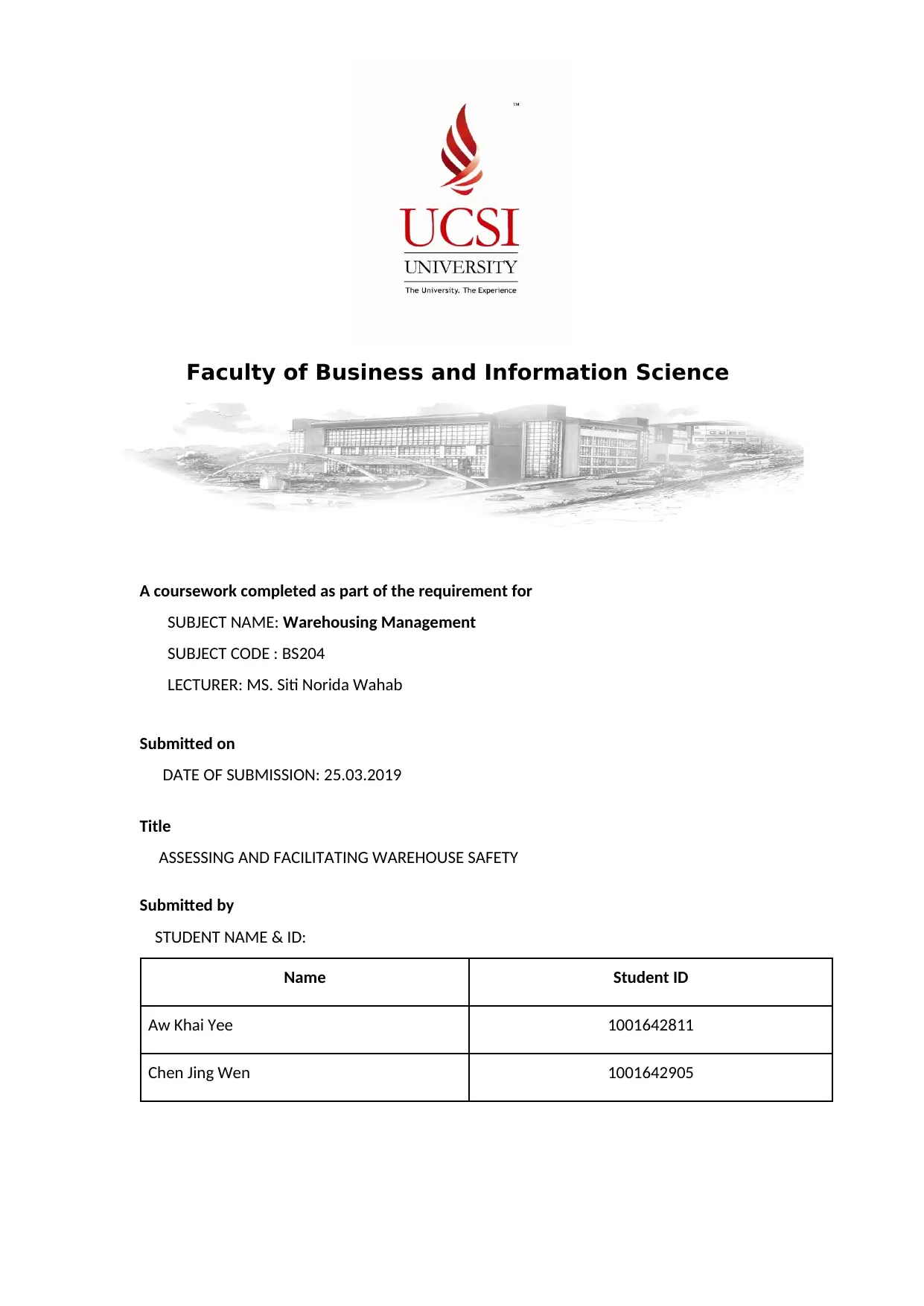
A coursework completed as part of the requirement for
SUBJECT NAME: Warehousing Management
SUBJECT CODE : BS204
LECTURER: MS. Siti Norida Wahab
Submitted on
DATE OF SUBMISSION: 25.03.2019
Title
ASSESSING AND FACILITATING WAREHOUSE SAFETY
Submitted by
STUDENT NAME & ID:
Name Student ID
Aw Khai Yee 1001642811
Chen Jing Wen 1001642905
Faculty of Business and Information Science
SUBJECT NAME: Warehousing Management
SUBJECT CODE : BS204
LECTURER: MS. Siti Norida Wahab
Submitted on
DATE OF SUBMISSION: 25.03.2019
Title
ASSESSING AND FACILITATING WAREHOUSE SAFETY
Submitted by
STUDENT NAME & ID:
Name Student ID
Aw Khai Yee 1001642811
Chen Jing Wen 1001642905
Faculty of Business and Information Science
Secure Best Marks with AI Grader
Need help grading? Try our AI Grader for instant feedback on your assignments.
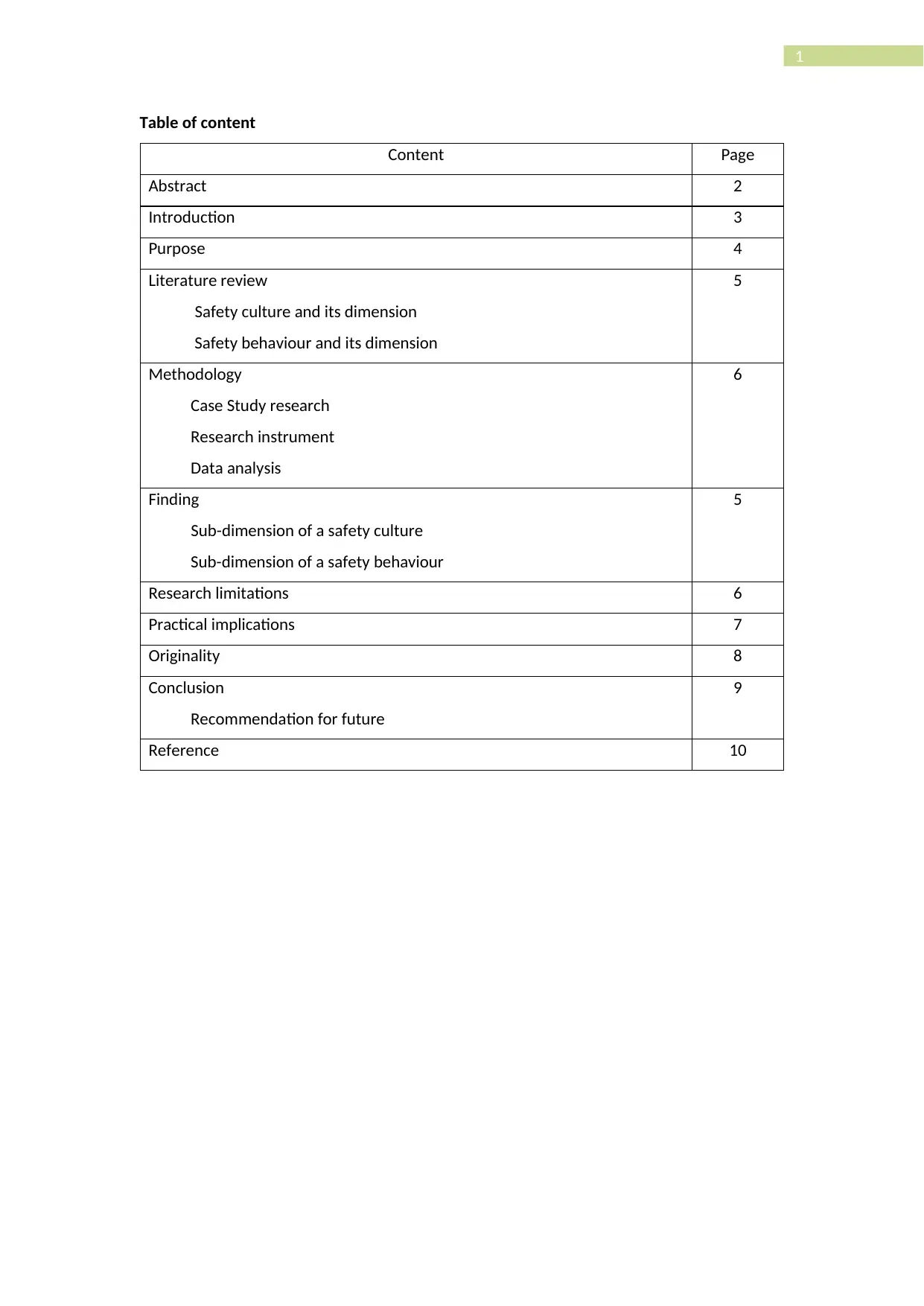
1
Table of content
Content Page
Abstract 2
Introduction 3
Purpose 4
Literature review
Safety culture and its dimension
Safety behaviour and its dimension
5
Methodology
Case Study research
Research instrument
Data analysis
6
Finding
Sub-dimension of a safety culture
Sub-dimension of a safety behaviour
5
Research limitations 6
Practical implications 7
Originality 8
Conclusion
Recommendation for future
9
Reference 10
Table of content
Content Page
Abstract 2
Introduction 3
Purpose 4
Literature review
Safety culture and its dimension
Safety behaviour and its dimension
5
Methodology
Case Study research
Research instrument
Data analysis
6
Finding
Sub-dimension of a safety culture
Sub-dimension of a safety behaviour
5
Research limitations 6
Practical implications 7
Originality 8
Conclusion
Recommendation for future
9
Reference 10
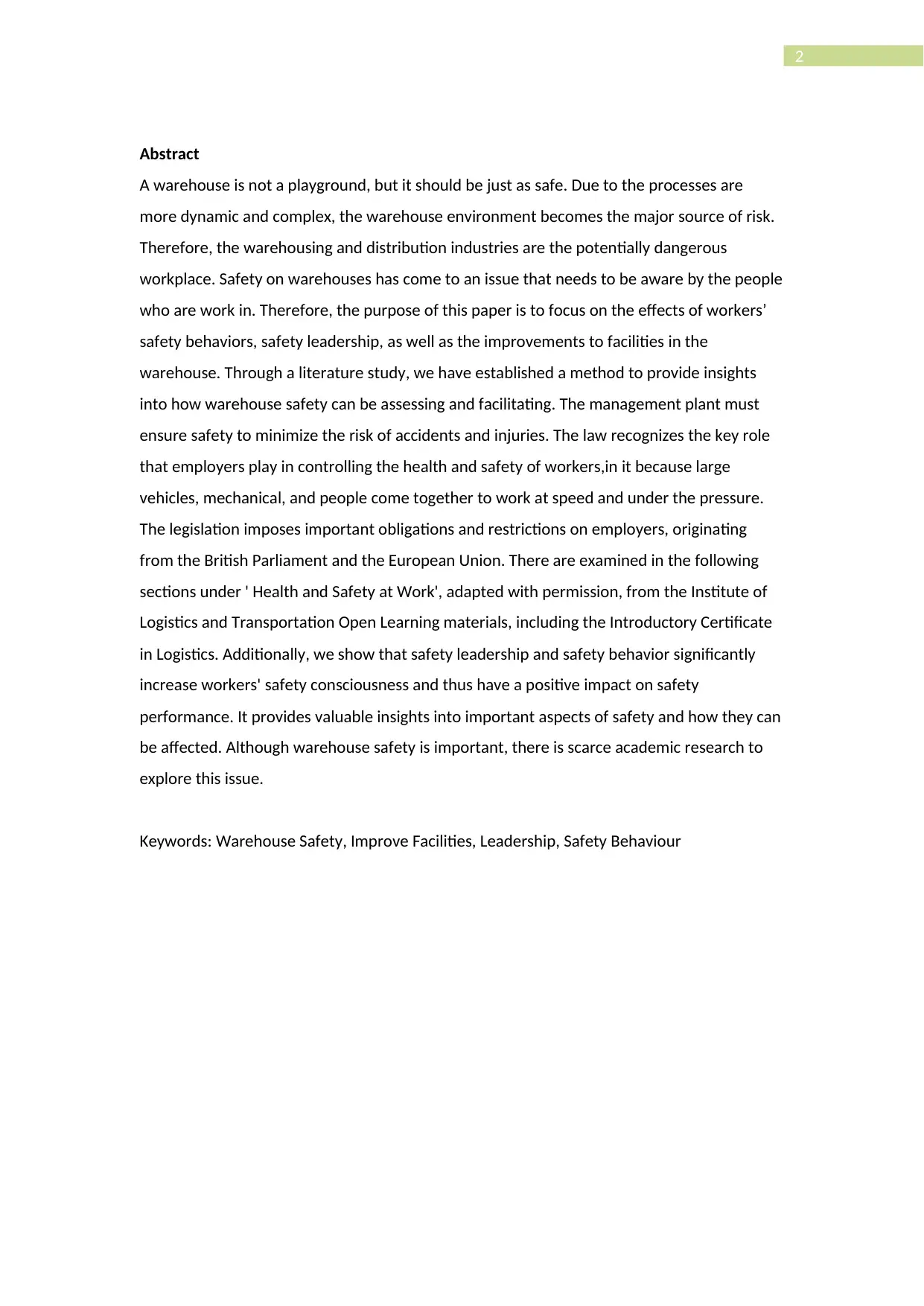
2
Abstract
A warehouse is not a playground, but it should be just as safe. Due to the processes are
more dynamic and complex, the warehouse environment becomes the major source of risk.
Therefore, the warehousing and distribution industries are the potentially dangerous
workplace. Safety on warehouses has come to an issue that needs to be aware by the people
who are work in. Therefore, the purpose of this paper is to focus on the effects of workers’
safety behaviors, safety leadership, as well as the improvements to facilities in the
warehouse. Through a literature study, we have established a method to provide insights
into how warehouse safety can be assessing and facilitating. The management plant must
ensure safety to minimize the risk of accidents and injuries. The law recognizes the key role
that employers play in controlling the health and safety of workers,in it because large
vehicles, mechanical, and people come together to work at speed and under the pressure.
The legislation imposes important obligations and restrictions on employers, originating
from the British Parliament and the European Union. There are examined in the following
sections under ' Health and Safety at Work', adapted with permission, from the Institute of
Logistics and Transportation Open Learning materials, including the Introductory Certificate
in Logistics. Additionally, we show that safety leadership and safety behavior significantly
increase workers' safety consciousness and thus have a positive impact on safety
performance. It provides valuable insights into important aspects of safety and how they can
be affected. Although warehouse safety is important, there is scarce academic research to
explore this issue.
Keywords: Warehouse Safety, Improve Facilities, Leadership, Safety Behaviour
Abstract
A warehouse is not a playground, but it should be just as safe. Due to the processes are
more dynamic and complex, the warehouse environment becomes the major source of risk.
Therefore, the warehousing and distribution industries are the potentially dangerous
workplace. Safety on warehouses has come to an issue that needs to be aware by the people
who are work in. Therefore, the purpose of this paper is to focus on the effects of workers’
safety behaviors, safety leadership, as well as the improvements to facilities in the
warehouse. Through a literature study, we have established a method to provide insights
into how warehouse safety can be assessing and facilitating. The management plant must
ensure safety to minimize the risk of accidents and injuries. The law recognizes the key role
that employers play in controlling the health and safety of workers,in it because large
vehicles, mechanical, and people come together to work at speed and under the pressure.
The legislation imposes important obligations and restrictions on employers, originating
from the British Parliament and the European Union. There are examined in the following
sections under ' Health and Safety at Work', adapted with permission, from the Institute of
Logistics and Transportation Open Learning materials, including the Introductory Certificate
in Logistics. Additionally, we show that safety leadership and safety behavior significantly
increase workers' safety consciousness and thus have a positive impact on safety
performance. It provides valuable insights into important aspects of safety and how they can
be affected. Although warehouse safety is important, there is scarce academic research to
explore this issue.
Keywords: Warehouse Safety, Improve Facilities, Leadership, Safety Behaviour
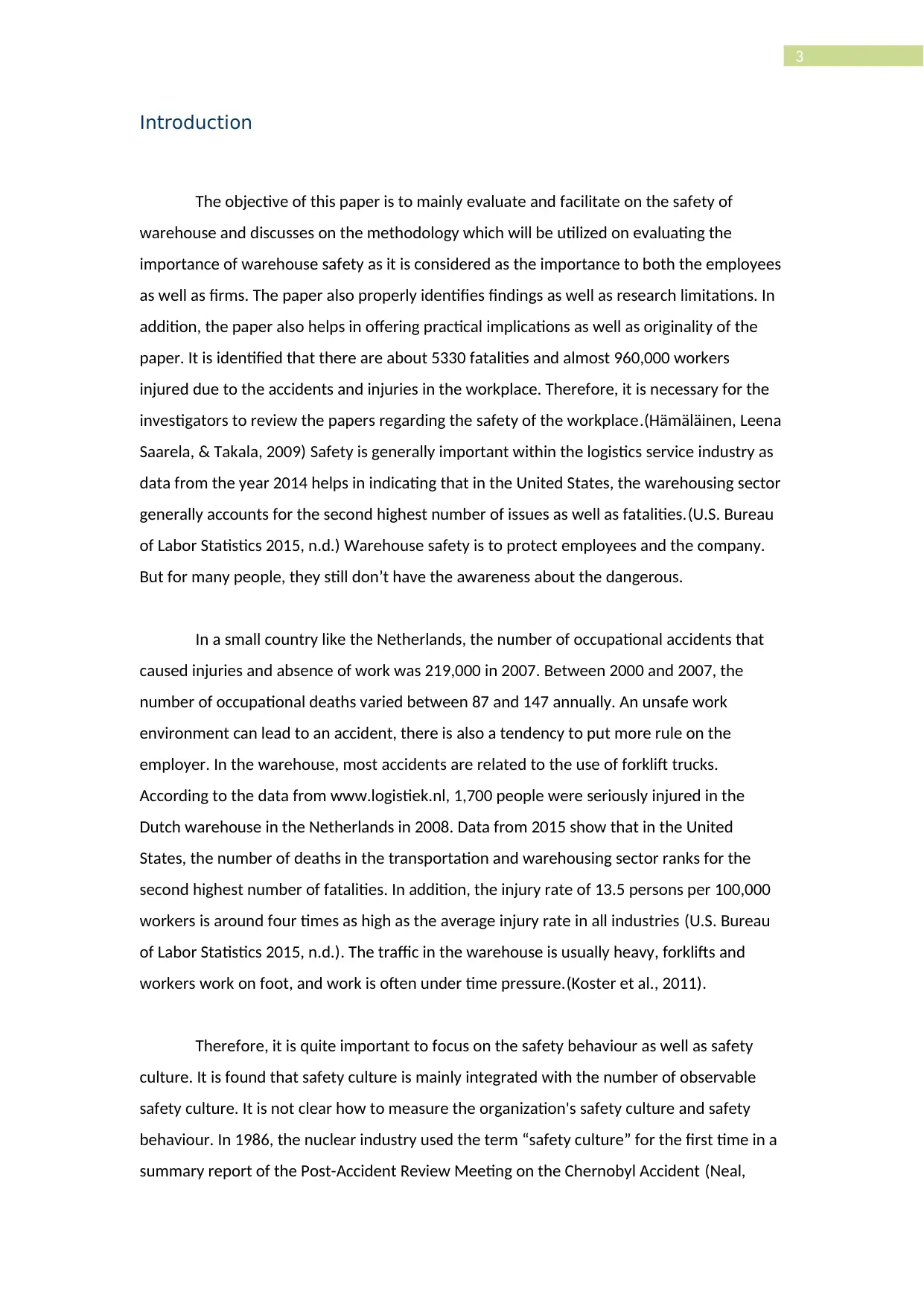
3
Introduction
The objective of this paper is to mainly evaluate and facilitate on the safety of
warehouse and discusses on the methodology which will be utilized on evaluating the
importance of warehouse safety as it is considered as the importance to both the employees
as well as firms. The paper also properly identifies findings as well as research limitations. In
addition, the paper also helps in offering practical implications as well as originality of the
paper. It is identified that there are about 5330 fatalities and almost 960,000 workers
injured due to the accidents and injuries in the workplace. Therefore, it is necessary for the
investigators to review the papers regarding the safety of the workplace.(Hämäläinen, Leena
Saarela, & Takala, 2009) Safety is generally important within the logistics service industry as
data from the year 2014 helps in indicating that in the United States, the warehousing sector
generally accounts for the second highest number of issues as well as fatalities.(U.S. Bureau
of Labor Statistics 2015, n.d.) Warehouse safety is to protect employees and the company.
But for many people, they still don’t have the awareness about the dangerous.
In a small country like the Netherlands, the number of occupational accidents that
caused injuries and absence of work was 219,000 in 2007. Between 2000 and 2007, the
number of occupational deaths varied between 87 and 147 annually. An unsafe work
environment can lead to an accident, there is also a tendency to put more rule on the
employer. In the warehouse, most accidents are related to the use of forklift trucks.
According to the data from www.logistiek.nl, 1,700 people were seriously injured in the
Dutch warehouse in the Netherlands in 2008. Data from 2015 show that in the United
States, the number of deaths in the transportation and warehousing sector ranks for the
second highest number of fatalities. In addition, the injury rate of 13.5 persons per 100,000
workers is around four times as high as the average injury rate in all industries (U.S. Bureau
of Labor Statistics 2015, n.d.). The traffic in the warehouse is usually heavy, forklifts and
workers work on foot, and work is often under time pressure.(Koster et al., 2011).
Therefore, it is quite important to focus on the safety behaviour as well as safety
culture. It is found that safety culture is mainly integrated with the number of observable
safety culture. It is not clear how to measure the organization's safety culture and safety
behaviour. In 1986, the nuclear industry used the term “safety culture” for the first time in a
summary report of the Post-Accident Review Meeting on the Chernobyl Accident (Neal,
Introduction
The objective of this paper is to mainly evaluate and facilitate on the safety of
warehouse and discusses on the methodology which will be utilized on evaluating the
importance of warehouse safety as it is considered as the importance to both the employees
as well as firms. The paper also properly identifies findings as well as research limitations. In
addition, the paper also helps in offering practical implications as well as originality of the
paper. It is identified that there are about 5330 fatalities and almost 960,000 workers
injured due to the accidents and injuries in the workplace. Therefore, it is necessary for the
investigators to review the papers regarding the safety of the workplace.(Hämäläinen, Leena
Saarela, & Takala, 2009) Safety is generally important within the logistics service industry as
data from the year 2014 helps in indicating that in the United States, the warehousing sector
generally accounts for the second highest number of issues as well as fatalities.(U.S. Bureau
of Labor Statistics 2015, n.d.) Warehouse safety is to protect employees and the company.
But for many people, they still don’t have the awareness about the dangerous.
In a small country like the Netherlands, the number of occupational accidents that
caused injuries and absence of work was 219,000 in 2007. Between 2000 and 2007, the
number of occupational deaths varied between 87 and 147 annually. An unsafe work
environment can lead to an accident, there is also a tendency to put more rule on the
employer. In the warehouse, most accidents are related to the use of forklift trucks.
According to the data from www.logistiek.nl, 1,700 people were seriously injured in the
Dutch warehouse in the Netherlands in 2008. Data from 2015 show that in the United
States, the number of deaths in the transportation and warehousing sector ranks for the
second highest number of fatalities. In addition, the injury rate of 13.5 persons per 100,000
workers is around four times as high as the average injury rate in all industries (U.S. Bureau
of Labor Statistics 2015, n.d.). The traffic in the warehouse is usually heavy, forklifts and
workers work on foot, and work is often under time pressure.(Koster et al., 2011).
Therefore, it is quite important to focus on the safety behaviour as well as safety
culture. It is found that safety culture is mainly integrated with the number of observable
safety culture. It is not clear how to measure the organization's safety culture and safety
behaviour. In 1986, the nuclear industry used the term “safety culture” for the first time in a
summary report of the Post-Accident Review Meeting on the Chernobyl Accident (Neal,
Secure Best Marks with AI Grader
Need help grading? Try our AI Grader for instant feedback on your assignments.

4
Griffin, & Hart, 2000)(Edwards, Davey, & Armstrong, 2013). There got many definitions of
safety culture have been published. The UK Health and Safety Committee has developed one
of the most commonly used definitions of safety culture. The product of individual and
group values, attitudes, perceptions, abilities and behavioural patterns that determine its
commitment, and the style and proficiency of, an organization's health and safety
management. "Organizations with a positive safety culture are characterized by
communications founded on mutual trust, by shared perceptions of the importance of safety
and by confidence in the efficacy of preventive measures." (HSC, 1993. ACSNI Study Group
on Human Factors. HMSO, London). Safety culture is the collection of the beliefs, ideas, and
values that employees associated with risks within an organization, such as a workplace or
community. Safety culture is a part of the organizational culture and is described in a variety
of ways (Rip, 1991). A good safety culture can be promoted by senior management
commitment to safety, the practical approach to dealing with hazards, ongoing
organizational learning, and attention to and concern for hazards shared across the
workforce. The safety culture of an organization can be a significant impact on the
performance of people in safety-related tasks and hence on the safety performance of the
organization.
Safety behaviour is behaviour associated with safety. It can refer to behaviour-based
safety, improving safety by monitoring and changing the behaviour of the people involved
and the stress-relieving activity performed by anxious people. In addition, improving safety
behaviour or active care behaviour requires more than just mitigation control. If
management can employ the Behaviour-Based Safety (BBS) approach, that would be
effective. The BBS concept aims to change unsafe behaviour into safe behaviour and
eliminate workplace accidents. The steps implemented by the BBS can be divided into four
main stages, namely, identification, observation, intervention, review, and monitoring.
(Ismail et al., 2012) BBS is not only suitable for the construction industry, but also for other
industries. (Chen & Tian, 2012) Using social recognition and motivating to conduct safe
behaviour will have a more positive impact on changing normal safety norms within the
group than the application.
Griffin, & Hart, 2000)(Edwards, Davey, & Armstrong, 2013). There got many definitions of
safety culture have been published. The UK Health and Safety Committee has developed one
of the most commonly used definitions of safety culture. The product of individual and
group values, attitudes, perceptions, abilities and behavioural patterns that determine its
commitment, and the style and proficiency of, an organization's health and safety
management. "Organizations with a positive safety culture are characterized by
communications founded on mutual trust, by shared perceptions of the importance of safety
and by confidence in the efficacy of preventive measures." (HSC, 1993. ACSNI Study Group
on Human Factors. HMSO, London). Safety culture is the collection of the beliefs, ideas, and
values that employees associated with risks within an organization, such as a workplace or
community. Safety culture is a part of the organizational culture and is described in a variety
of ways (Rip, 1991). A good safety culture can be promoted by senior management
commitment to safety, the practical approach to dealing with hazards, ongoing
organizational learning, and attention to and concern for hazards shared across the
workforce. The safety culture of an organization can be a significant impact on the
performance of people in safety-related tasks and hence on the safety performance of the
organization.
Safety behaviour is behaviour associated with safety. It can refer to behaviour-based
safety, improving safety by monitoring and changing the behaviour of the people involved
and the stress-relieving activity performed by anxious people. In addition, improving safety
behaviour or active care behaviour requires more than just mitigation control. If
management can employ the Behaviour-Based Safety (BBS) approach, that would be
effective. The BBS concept aims to change unsafe behaviour into safe behaviour and
eliminate workplace accidents. The steps implemented by the BBS can be divided into four
main stages, namely, identification, observation, intervention, review, and monitoring.
(Ismail et al., 2012) BBS is not only suitable for the construction industry, but also for other
industries. (Chen & Tian, 2012) Using social recognition and motivating to conduct safe
behaviour will have a more positive impact on changing normal safety norms within the
group than the application.
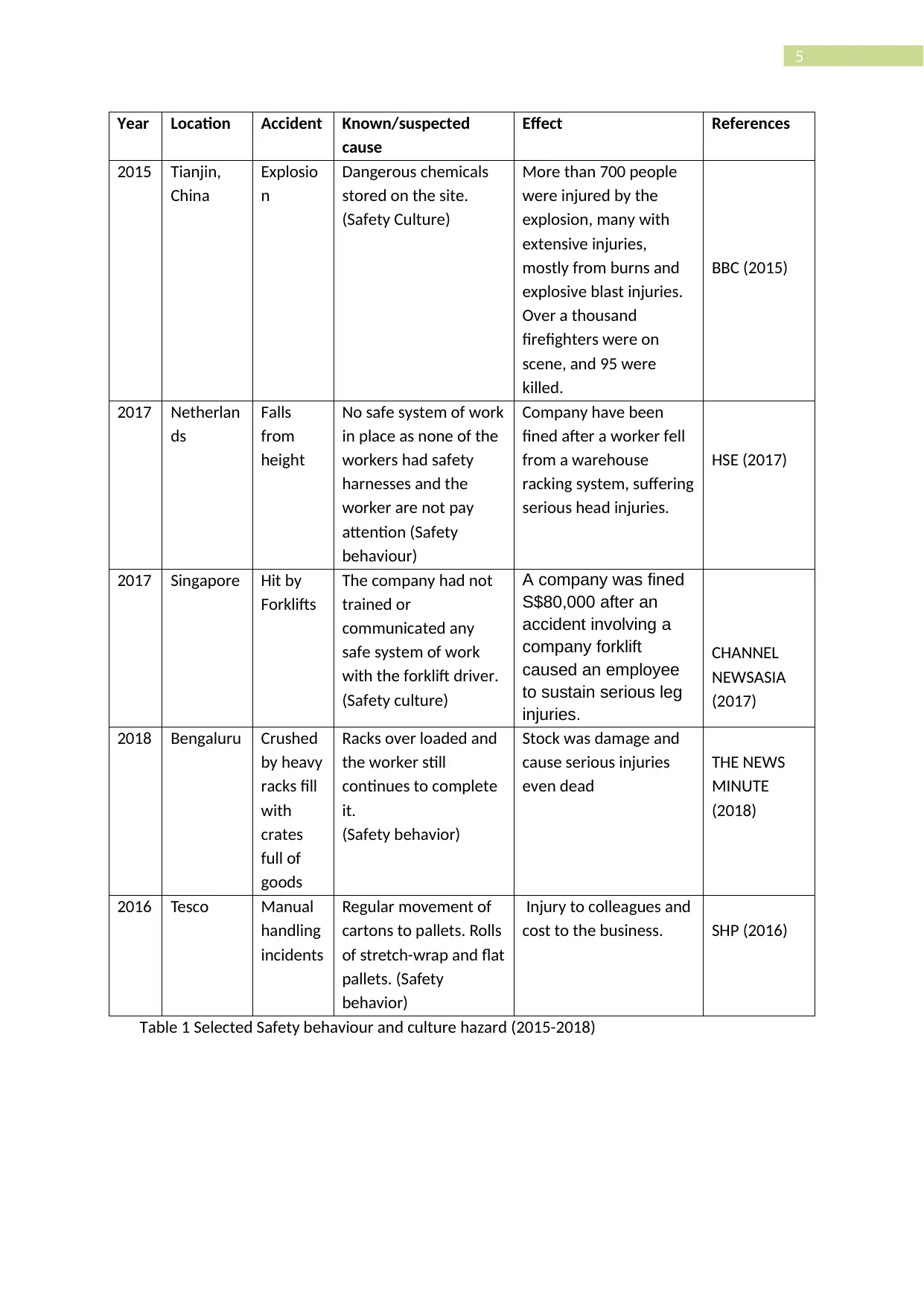
5
Year Location Accident Known/suspected
cause
Effect References
2015 Tianjin,
China
Explosio
n
Dangerous chemicals
stored on the site.
(Safety Culture)
More than 700 people
were injured by the
explosion, many with
extensive injuries,
mostly from burns and
explosive blast injuries.
Over a thousand
firefighters were on
scene, and 95 were
killed.
BBC (2015)
2017 Netherlan
ds
Falls
from
height
No safe system of work
in place as none of the
workers had safety
harnesses and the
worker are not pay
attention (Safety
behaviour)
Company have been
fined after a worker fell
from a warehouse
racking system, suffering
serious head injuries.
HSE (2017)
2017 Singapore Hit by
Forklifts
The company had not
trained or
communicated any
safe system of work
with the forklift driver.
(Safety culture)
A company was fined
S$80,000 after an
accident involving a
company forklift
caused an employee
to sustain serious leg
injuries.
CHANNEL
NEWSASIA
(2017)
2018 Bengaluru Crushed
by heavy
racks fill
with
crates
full of
goods
Racks over loaded and
the worker still
continues to complete
it.
(Safety behavior)
Stock was damage and
cause serious injuries
even dead
THE NEWS
MINUTE
(2018)
2016 Tesco Manual
handling
incidents
Regular movement of
cartons to pallets. Rolls
of stretch-wrap and flat
pallets. (Safety
behavior)
Injury to colleagues and
cost to the business. SHP (2016)
Table 1 Selected Safety behaviour and culture hazard (2015-2018)
Year Location Accident Known/suspected
cause
Effect References
2015 Tianjin,
China
Explosio
n
Dangerous chemicals
stored on the site.
(Safety Culture)
More than 700 people
were injured by the
explosion, many with
extensive injuries,
mostly from burns and
explosive blast injuries.
Over a thousand
firefighters were on
scene, and 95 were
killed.
BBC (2015)
2017 Netherlan
ds
Falls
from
height
No safe system of work
in place as none of the
workers had safety
harnesses and the
worker are not pay
attention (Safety
behaviour)
Company have been
fined after a worker fell
from a warehouse
racking system, suffering
serious head injuries.
HSE (2017)
2017 Singapore Hit by
Forklifts
The company had not
trained or
communicated any
safe system of work
with the forklift driver.
(Safety culture)
A company was fined
S$80,000 after an
accident involving a
company forklift
caused an employee
to sustain serious leg
injuries.
CHANNEL
NEWSASIA
(2017)
2018 Bengaluru Crushed
by heavy
racks fill
with
crates
full of
goods
Racks over loaded and
the worker still
continues to complete
it.
(Safety behavior)
Stock was damage and
cause serious injuries
even dead
THE NEWS
MINUTE
(2018)
2016 Tesco Manual
handling
incidents
Regular movement of
cartons to pallets. Rolls
of stretch-wrap and flat
pallets. (Safety
behavior)
Injury to colleagues and
cost to the business. SHP (2016)
Table 1 Selected Safety behaviour and culture hazard (2015-2018)
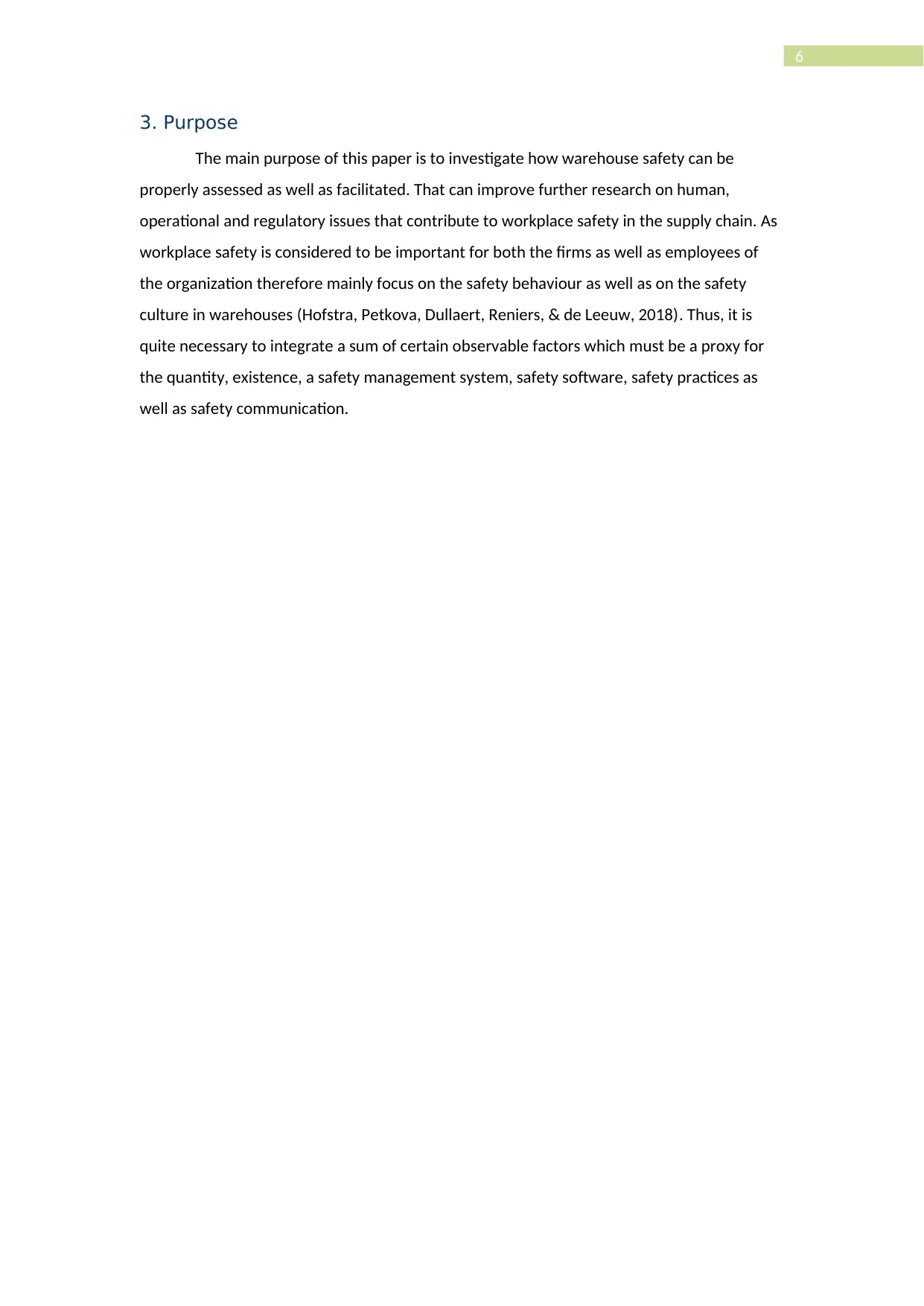
6
3. Purpose
The main purpose of this paper is to investigate how warehouse safety can be
properly assessed as well as facilitated. That can improve further research on human,
operational and regulatory issues that contribute to workplace safety in the supply chain. As
workplace safety is considered to be important for both the firms as well as employees of
the organization therefore mainly focus on the safety behaviour as well as on the safety
culture in warehouses (Hofstra, Petkova, Dullaert, Reniers, & de Leeuw, 2018). Thus, it is
quite necessary to integrate a sum of certain observable factors which must be a proxy for
the quantity, existence, a safety management system, safety software, safety practices as
well as safety communication.
3. Purpose
The main purpose of this paper is to investigate how warehouse safety can be
properly assessed as well as facilitated. That can improve further research on human,
operational and regulatory issues that contribute to workplace safety in the supply chain. As
workplace safety is considered to be important for both the firms as well as employees of
the organization therefore mainly focus on the safety behaviour as well as on the safety
culture in warehouses (Hofstra, Petkova, Dullaert, Reniers, & de Leeuw, 2018). Thus, it is
quite necessary to integrate a sum of certain observable factors which must be a proxy for
the quantity, existence, a safety management system, safety software, safety practices as
well as safety communication.
Paraphrase This Document
Need a fresh take? Get an instant paraphrase of this document with our AI Paraphraser
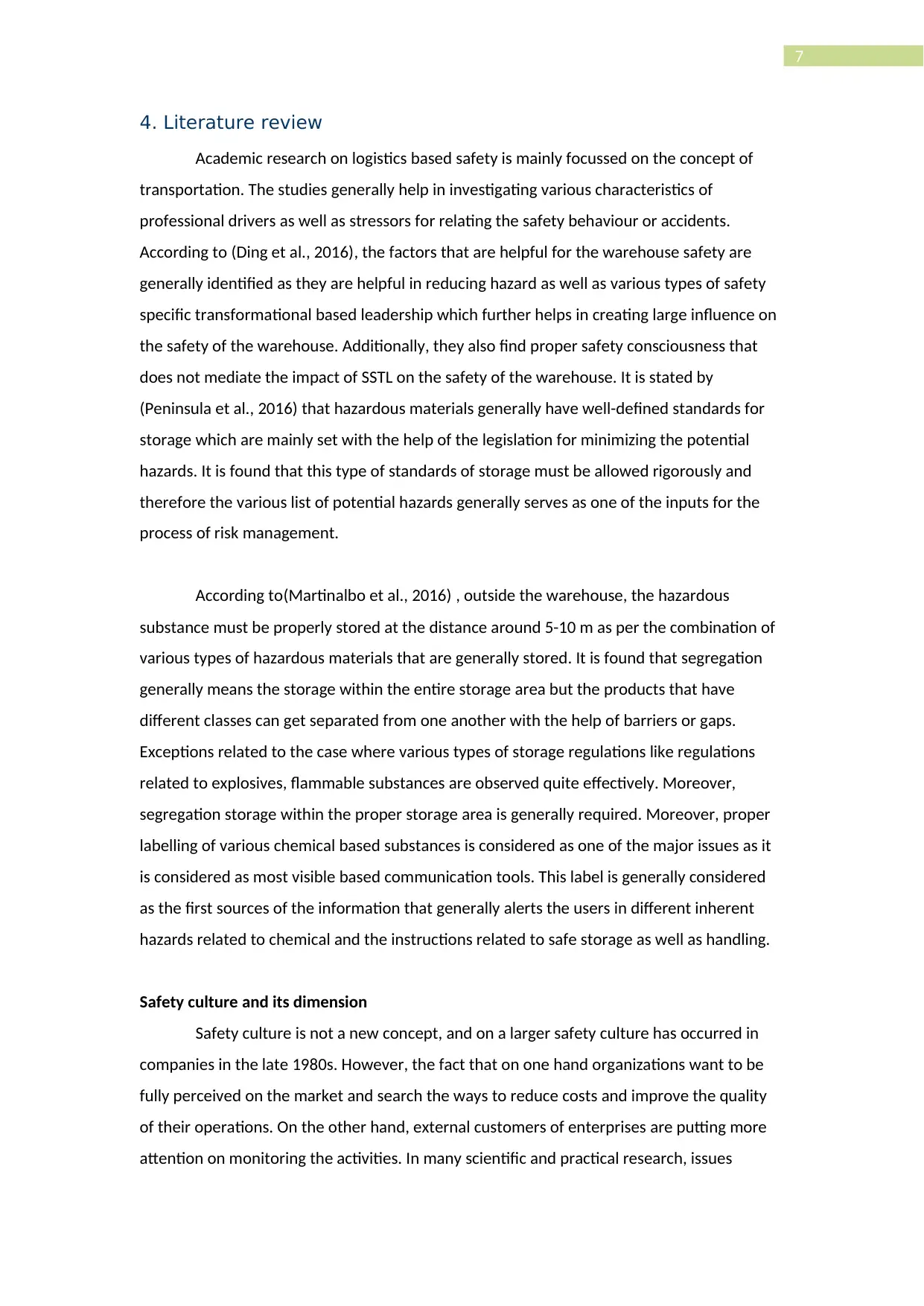
7
4. Literature review
Academic research on logistics based safety is mainly focussed on the concept of
transportation. The studies generally help in investigating various characteristics of
professional drivers as well as stressors for relating the safety behaviour or accidents.
According to (Ding et al., 2016), the factors that are helpful for the warehouse safety are
generally identified as they are helpful in reducing hazard as well as various types of safety
specific transformational based leadership which further helps in creating large influence on
the safety of the warehouse. Additionally, they also find proper safety consciousness that
does not mediate the impact of SSTL on the safety of the warehouse. It is stated by
(Peninsula et al., 2016) that hazardous materials generally have well-defined standards for
storage which are mainly set with the help of the legislation for minimizing the potential
hazards. It is found that this type of standards of storage must be allowed rigorously and
therefore the various list of potential hazards generally serves as one of the inputs for the
process of risk management.
According to(Martinalbo et al., 2016) , outside the warehouse, the hazardous
substance must be properly stored at the distance around 5-10 m as per the combination of
various types of hazardous materials that are generally stored. It is found that segregation
generally means the storage within the entire storage area but the products that have
different classes can get separated from one another with the help of barriers or gaps.
Exceptions related to the case where various types of storage regulations like regulations
related to explosives, flammable substances are observed quite effectively. Moreover,
segregation storage within the proper storage area is generally required. Moreover, proper
labelling of various chemical based substances is considered as one of the major issues as it
is considered as most visible based communication tools. This label is generally considered
as the first sources of the information that generally alerts the users in different inherent
hazards related to chemical and the instructions related to safe storage as well as handling.
Safety culture and its dimension
Safety culture is not a new concept, and on a larger safety culture has occurred in
companies in the late 1980s. However, the fact that on one hand organizations want to be
fully perceived on the market and search the ways to reduce costs and improve the quality
of their operations. On the other hand, external customers of enterprises are putting more
attention on monitoring the activities. In many scientific and practical research, issues
4. Literature review
Academic research on logistics based safety is mainly focussed on the concept of
transportation. The studies generally help in investigating various characteristics of
professional drivers as well as stressors for relating the safety behaviour or accidents.
According to (Ding et al., 2016), the factors that are helpful for the warehouse safety are
generally identified as they are helpful in reducing hazard as well as various types of safety
specific transformational based leadership which further helps in creating large influence on
the safety of the warehouse. Additionally, they also find proper safety consciousness that
does not mediate the impact of SSTL on the safety of the warehouse. It is stated by
(Peninsula et al., 2016) that hazardous materials generally have well-defined standards for
storage which are mainly set with the help of the legislation for minimizing the potential
hazards. It is found that this type of standards of storage must be allowed rigorously and
therefore the various list of potential hazards generally serves as one of the inputs for the
process of risk management.
According to(Martinalbo et al., 2016) , outside the warehouse, the hazardous
substance must be properly stored at the distance around 5-10 m as per the combination of
various types of hazardous materials that are generally stored. It is found that segregation
generally means the storage within the entire storage area but the products that have
different classes can get separated from one another with the help of barriers or gaps.
Exceptions related to the case where various types of storage regulations like regulations
related to explosives, flammable substances are observed quite effectively. Moreover,
segregation storage within the proper storage area is generally required. Moreover, proper
labelling of various chemical based substances is considered as one of the major issues as it
is considered as most visible based communication tools. This label is generally considered
as the first sources of the information that generally alerts the users in different inherent
hazards related to chemical and the instructions related to safe storage as well as handling.
Safety culture and its dimension
Safety culture is not a new concept, and on a larger safety culture has occurred in
companies in the late 1980s. However, the fact that on one hand organizations want to be
fully perceived on the market and search the ways to reduce costs and improve the quality
of their operations. On the other hand, external customers of enterprises are putting more
attention on monitoring the activities. In many scientific and practical research, issues
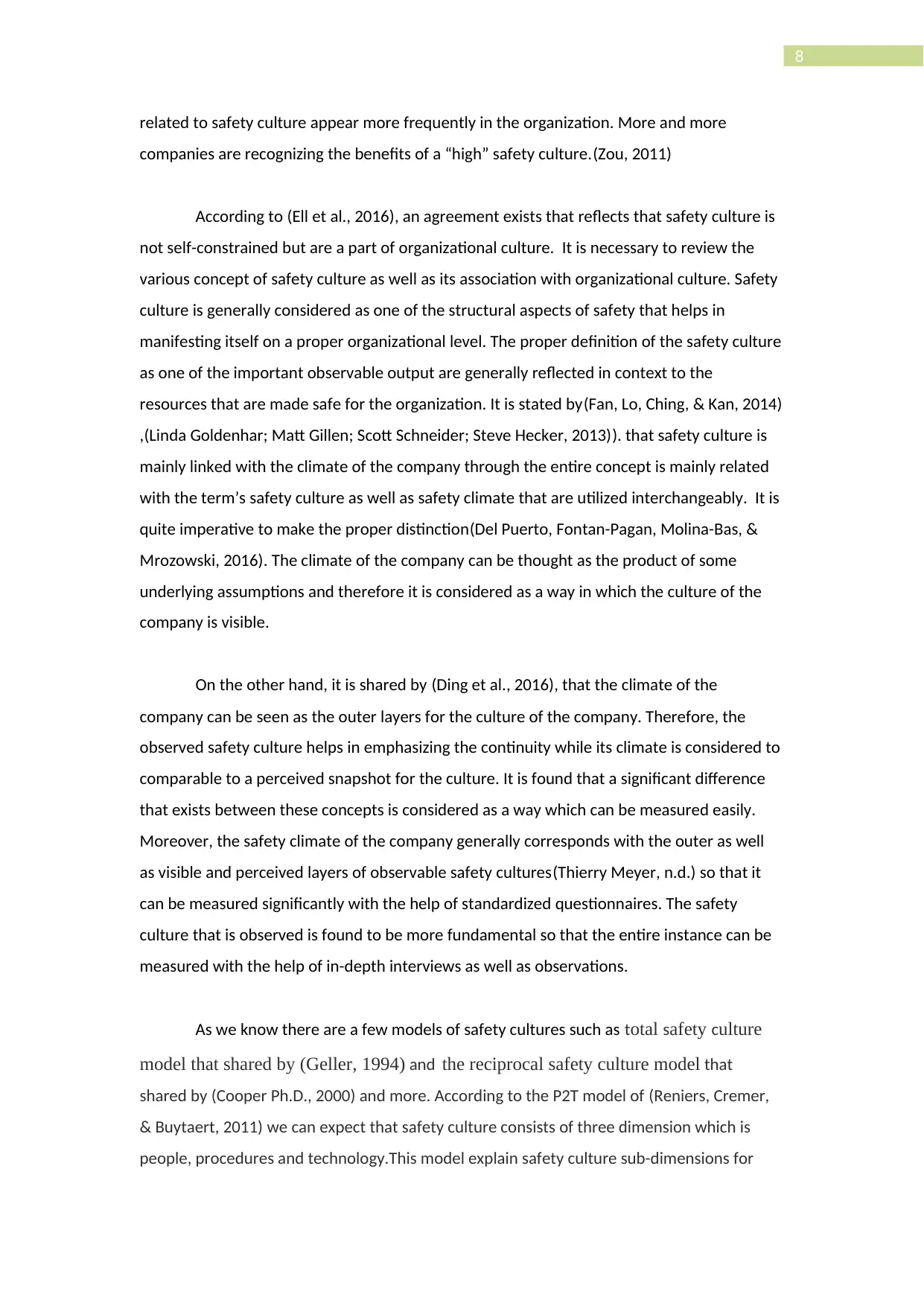
8
related to safety culture appear more frequently in the organization. More and more
companies are recognizing the benefits of a “high” safety culture.(Zou, 2011)
According to (Ell et al., 2016), an agreement exists that reflects that safety culture is
not self-constrained but are a part of organizational culture. It is necessary to review the
various concept of safety culture as well as its association with organizational culture. Safety
culture is generally considered as one of the structural aspects of safety that helps in
manifesting itself on a proper organizational level. The proper definition of the safety culture
as one of the important observable output are generally reflected in context to the
resources that are made safe for the organization. It is stated by(Fan, Lo, Ching, & Kan, 2014)
,(Linda Goldenhar; Matt Gillen; Scott Schneider; Steve Hecker, 2013)). that safety culture is
mainly linked with the climate of the company through the entire concept is mainly related
with the term’s safety culture as well as safety climate that are utilized interchangeably. It is
quite imperative to make the proper distinction(Del Puerto, Fontan-Pagan, Molina-Bas, &
Mrozowski, 2016). The climate of the company can be thought as the product of some
underlying assumptions and therefore it is considered as a way in which the culture of the
company is visible.
On the other hand, it is shared by (Ding et al., 2016), that the climate of the
company can be seen as the outer layers for the culture of the company. Therefore, the
observed safety culture helps in emphasizing the continuity while its climate is considered to
comparable to a perceived snapshot for the culture. It is found that a significant difference
that exists between these concepts is considered as a way which can be measured easily.
Moreover, the safety climate of the company generally corresponds with the outer as well
as visible and perceived layers of observable safety cultures(Thierry Meyer, n.d.) so that it
can be measured significantly with the help of standardized questionnaires. The safety
culture that is observed is found to be more fundamental so that the entire instance can be
measured with the help of in-depth interviews as well as observations.
As we know there are a few models of safety cultures such as total safety culture
model that shared by (Geller, 1994) and the reciprocal safety culture model that
shared by (Cooper Ph.D., 2000) and more. According to the P2T model of (Reniers, Cremer,
& Buytaert, 2011) we can expect that safety culture consists of three dimension which is
people, procedures and technology.This model explain safety culture sub-dimensions for
related to safety culture appear more frequently in the organization. More and more
companies are recognizing the benefits of a “high” safety culture.(Zou, 2011)
According to (Ell et al., 2016), an agreement exists that reflects that safety culture is
not self-constrained but are a part of organizational culture. It is necessary to review the
various concept of safety culture as well as its association with organizational culture. Safety
culture is generally considered as one of the structural aspects of safety that helps in
manifesting itself on a proper organizational level. The proper definition of the safety culture
as one of the important observable output are generally reflected in context to the
resources that are made safe for the organization. It is stated by(Fan, Lo, Ching, & Kan, 2014)
,(Linda Goldenhar; Matt Gillen; Scott Schneider; Steve Hecker, 2013)). that safety culture is
mainly linked with the climate of the company through the entire concept is mainly related
with the term’s safety culture as well as safety climate that are utilized interchangeably. It is
quite imperative to make the proper distinction(Del Puerto, Fontan-Pagan, Molina-Bas, &
Mrozowski, 2016). The climate of the company can be thought as the product of some
underlying assumptions and therefore it is considered as a way in which the culture of the
company is visible.
On the other hand, it is shared by (Ding et al., 2016), that the climate of the
company can be seen as the outer layers for the culture of the company. Therefore, the
observed safety culture helps in emphasizing the continuity while its climate is considered to
comparable to a perceived snapshot for the culture. It is found that a significant difference
that exists between these concepts is considered as a way which can be measured easily.
Moreover, the safety climate of the company generally corresponds with the outer as well
as visible and perceived layers of observable safety cultures(Thierry Meyer, n.d.) so that it
can be measured significantly with the help of standardized questionnaires. The safety
culture that is observed is found to be more fundamental so that the entire instance can be
measured with the help of in-depth interviews as well as observations.
As we know there are a few models of safety cultures such as total safety culture
model that shared by (Geller, 1994) and the reciprocal safety culture model that
shared by (Cooper Ph.D., 2000) and more. According to the P2T model of (Reniers, Cremer,
& Buytaert, 2011) we can expect that safety culture consists of three dimension which is
people, procedures and technology.This model explain safety culture sub-dimensions for
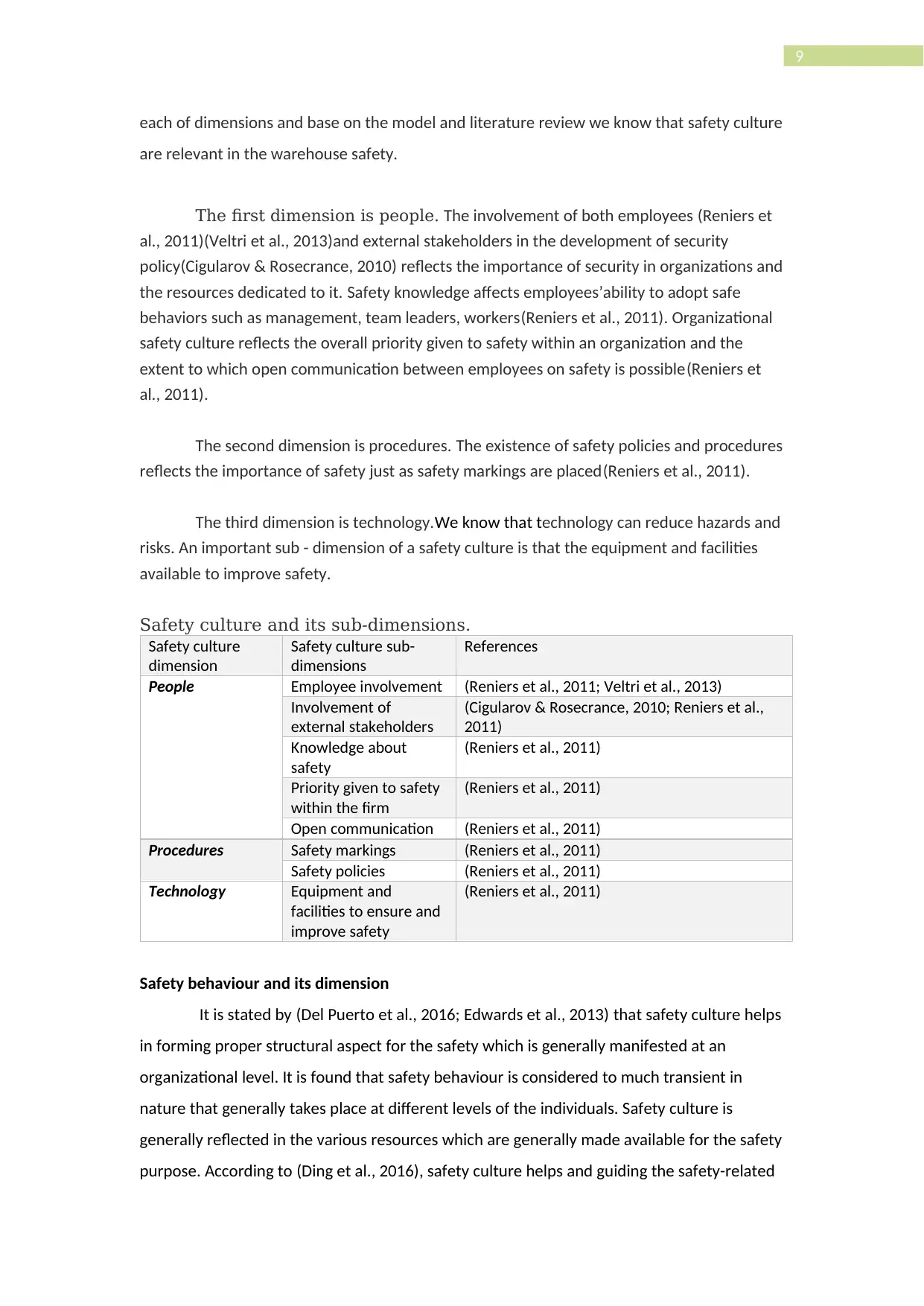
9
each of dimensions and base on the model and literature review we know that safety culture
are relevant in the warehouse safety.
The first dimension is people. The involvement of both employees (Reniers et
al., 2011)(Veltri et al., 2013)and external stakeholders in the development of security
policy(Cigularov & Rosecrance, 2010) reflects the importance of security in organizations and
the resources dedicated to it. Safety knowledge affects employees’ability to adopt safe
behaviors such as management, team leaders, workers(Reniers et al., 2011). Organizational
safety culture reflects the overall priority given to safety within an organization and the
extent to which open communication between employees on safety is possible(Reniers et
al., 2011).
The second dimension is procedures. The existence of safety policies and procedures
reflects the importance of safety just as safety markings are placed(Reniers et al., 2011).
The third dimension is technology.We know that technology can reduce hazards and
risks. An important sub - dimension of a safety culture is that the equipment and facilities
available to improve safety.
Safety culture and its sub-dimensions.
Safety culture
dimension
Safety culture sub-
dimensions
References
People Employee involvement (Reniers et al., 2011; Veltri et al., 2013)
Involvement of
external stakeholders
(Cigularov & Rosecrance, 2010; Reniers et al.,
2011)
Knowledge about
safety
(Reniers et al., 2011)
Priority given to safety
within the firm
(Reniers et al., 2011)
Open communication (Reniers et al., 2011)
Procedures Safety markings (Reniers et al., 2011)
Safety policies (Reniers et al., 2011)
Technology Equipment and
facilities to ensure and
improve safety
(Reniers et al., 2011)
Safety behaviour and its dimension
It is stated by (Del Puerto et al., 2016; Edwards et al., 2013) that safety culture helps
in forming proper structural aspect for the safety which is generally manifested at an
organizational level. It is found that safety behaviour is considered to much transient in
nature that generally takes place at different levels of the individuals. Safety culture is
generally reflected in the various resources which are generally made available for the safety
purpose. According to (Ding et al., 2016), safety culture helps and guiding the safety-related
each of dimensions and base on the model and literature review we know that safety culture
are relevant in the warehouse safety.
The first dimension is people. The involvement of both employees (Reniers et
al., 2011)(Veltri et al., 2013)and external stakeholders in the development of security
policy(Cigularov & Rosecrance, 2010) reflects the importance of security in organizations and
the resources dedicated to it. Safety knowledge affects employees’ability to adopt safe
behaviors such as management, team leaders, workers(Reniers et al., 2011). Organizational
safety culture reflects the overall priority given to safety within an organization and the
extent to which open communication between employees on safety is possible(Reniers et
al., 2011).
The second dimension is procedures. The existence of safety policies and procedures
reflects the importance of safety just as safety markings are placed(Reniers et al., 2011).
The third dimension is technology.We know that technology can reduce hazards and
risks. An important sub - dimension of a safety culture is that the equipment and facilities
available to improve safety.
Safety culture and its sub-dimensions.
Safety culture
dimension
Safety culture sub-
dimensions
References
People Employee involvement (Reniers et al., 2011; Veltri et al., 2013)
Involvement of
external stakeholders
(Cigularov & Rosecrance, 2010; Reniers et al.,
2011)
Knowledge about
safety
(Reniers et al., 2011)
Priority given to safety
within the firm
(Reniers et al., 2011)
Open communication (Reniers et al., 2011)
Procedures Safety markings (Reniers et al., 2011)
Safety policies (Reniers et al., 2011)
Technology Equipment and
facilities to ensure and
improve safety
(Reniers et al., 2011)
Safety behaviour and its dimension
It is stated by (Del Puerto et al., 2016; Edwards et al., 2013) that safety culture helps
in forming proper structural aspect for the safety which is generally manifested at an
organizational level. It is found that safety behaviour is considered to much transient in
nature that generally takes place at different levels of the individuals. Safety culture is
generally reflected in the various resources which are generally made available for the safety
purpose. According to (Ding et al., 2016), safety culture helps and guiding the safety-related
Secure Best Marks with AI Grader
Need help grading? Try our AI Grader for instant feedback on your assignments.
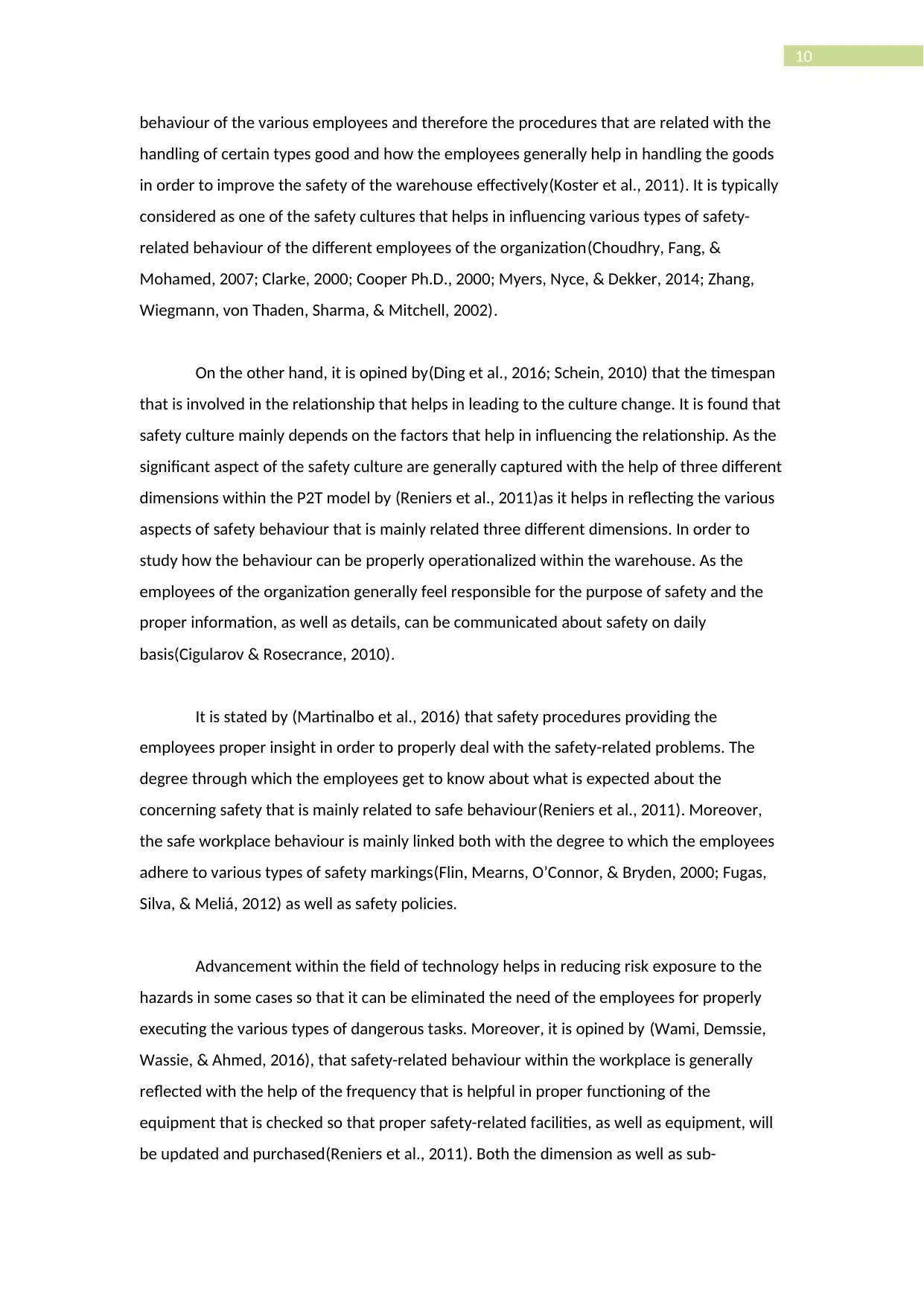
10
behaviour of the various employees and therefore the procedures that are related with the
handling of certain types good and how the employees generally help in handling the goods
in order to improve the safety of the warehouse effectively(Koster et al., 2011). It is typically
considered as one of the safety cultures that helps in influencing various types of safety-
related behaviour of the different employees of the organization(Choudhry, Fang, &
Mohamed, 2007; Clarke, 2000; Cooper Ph.D., 2000; Myers, Nyce, & Dekker, 2014; Zhang,
Wiegmann, von Thaden, Sharma, & Mitchell, 2002).
On the other hand, it is opined by(Ding et al., 2016; Schein, 2010) that the timespan
that is involved in the relationship that helps in leading to the culture change. It is found that
safety culture mainly depends on the factors that help in influencing the relationship. As the
significant aspect of the safety culture are generally captured with the help of three different
dimensions within the P2T model by (Reniers et al., 2011)as it helps in reflecting the various
aspects of safety behaviour that is mainly related three different dimensions. In order to
study how the behaviour can be properly operationalized within the warehouse. As the
employees of the organization generally feel responsible for the purpose of safety and the
proper information, as well as details, can be communicated about safety on daily
basis(Cigularov & Rosecrance, 2010).
It is stated by (Martinalbo et al., 2016) that safety procedures providing the
employees proper insight in order to properly deal with the safety-related problems. The
degree through which the employees get to know about what is expected about the
concerning safety that is mainly related to safe behaviour(Reniers et al., 2011). Moreover,
the safe workplace behaviour is mainly linked both with the degree to which the employees
adhere to various types of safety markings(Flin, Mearns, O’Connor, & Bryden, 2000; Fugas,
Silva, & Meliá, 2012) as well as safety policies.
Advancement within the field of technology helps in reducing risk exposure to the
hazards in some cases so that it can be eliminated the need of the employees for properly
executing the various types of dangerous tasks. Moreover, it is opined by (Wami, Demssie,
Wassie, & Ahmed, 2016), that safety-related behaviour within the workplace is generally
reflected with the help of the frequency that is helpful in proper functioning of the
equipment that is checked so that proper safety-related facilities, as well as equipment, will
be updated and purchased(Reniers et al., 2011). Both the dimension as well as sub-
behaviour of the various employees and therefore the procedures that are related with the
handling of certain types good and how the employees generally help in handling the goods
in order to improve the safety of the warehouse effectively(Koster et al., 2011). It is typically
considered as one of the safety cultures that helps in influencing various types of safety-
related behaviour of the different employees of the organization(Choudhry, Fang, &
Mohamed, 2007; Clarke, 2000; Cooper Ph.D., 2000; Myers, Nyce, & Dekker, 2014; Zhang,
Wiegmann, von Thaden, Sharma, & Mitchell, 2002).
On the other hand, it is opined by(Ding et al., 2016; Schein, 2010) that the timespan
that is involved in the relationship that helps in leading to the culture change. It is found that
safety culture mainly depends on the factors that help in influencing the relationship. As the
significant aspect of the safety culture are generally captured with the help of three different
dimensions within the P2T model by (Reniers et al., 2011)as it helps in reflecting the various
aspects of safety behaviour that is mainly related three different dimensions. In order to
study how the behaviour can be properly operationalized within the warehouse. As the
employees of the organization generally feel responsible for the purpose of safety and the
proper information, as well as details, can be communicated about safety on daily
basis(Cigularov & Rosecrance, 2010).
It is stated by (Martinalbo et al., 2016) that safety procedures providing the
employees proper insight in order to properly deal with the safety-related problems. The
degree through which the employees get to know about what is expected about the
concerning safety that is mainly related to safe behaviour(Reniers et al., 2011). Moreover,
the safe workplace behaviour is mainly linked both with the degree to which the employees
adhere to various types of safety markings(Flin, Mearns, O’Connor, & Bryden, 2000; Fugas,
Silva, & Meliá, 2012) as well as safety policies.
Advancement within the field of technology helps in reducing risk exposure to the
hazards in some cases so that it can be eliminated the need of the employees for properly
executing the various types of dangerous tasks. Moreover, it is opined by (Wami, Demssie,
Wassie, & Ahmed, 2016), that safety-related behaviour within the workplace is generally
reflected with the help of the frequency that is helpful in proper functioning of the
equipment that is checked so that proper safety-related facilities, as well as equipment, will
be updated and purchased(Reniers et al., 2011). Both the dimension as well as sub-
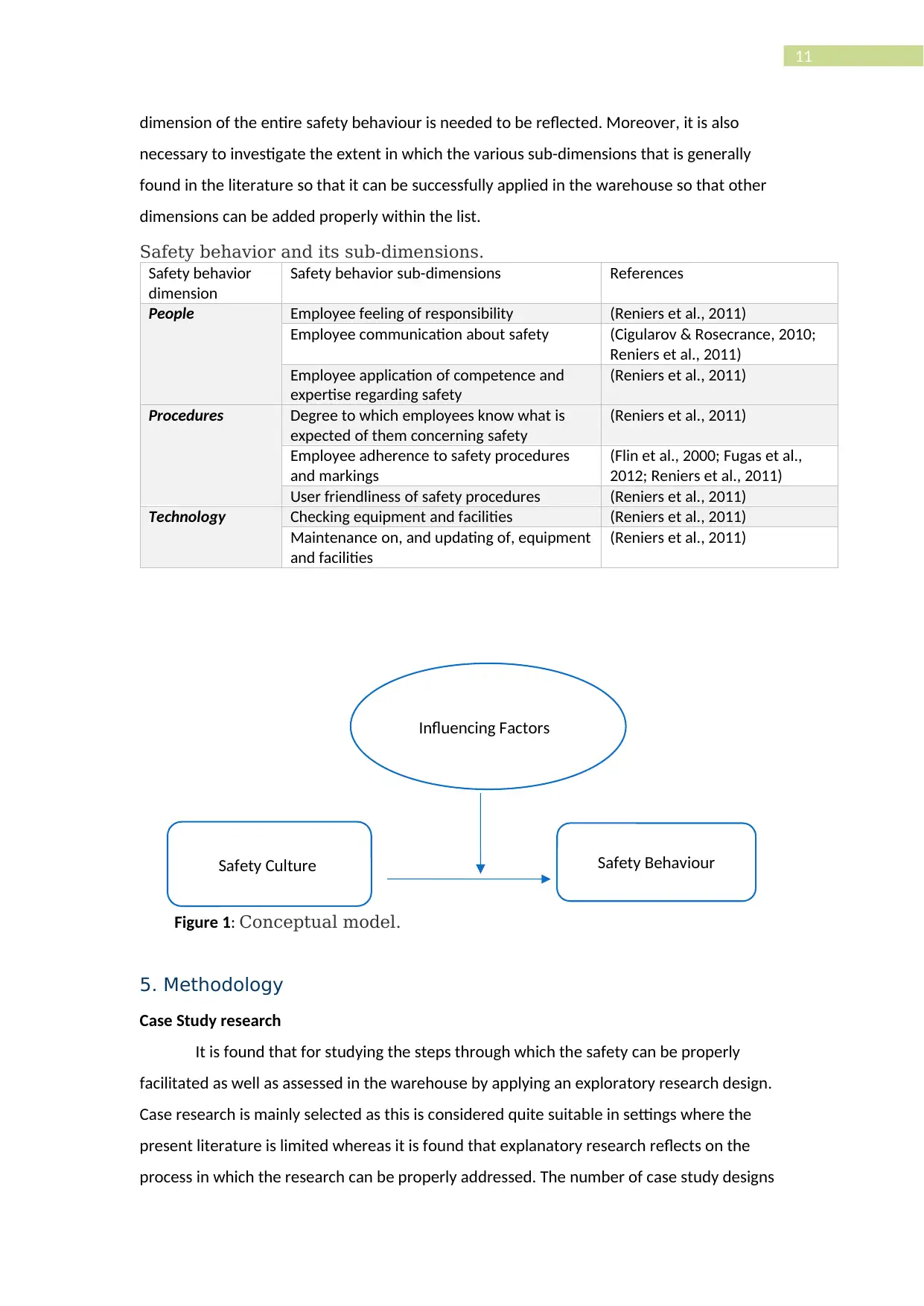
11
dimension of the entire safety behaviour is needed to be reflected. Moreover, it is also
necessary to investigate the extent in which the various sub-dimensions that is generally
found in the literature so that it can be successfully applied in the warehouse so that other
dimensions can be added properly within the list.
Safety behavior and its sub-dimensions.
Safety behavior
dimension
Safety behavior sub-dimensions References
People Employee feeling of responsibility (Reniers et al., 2011)
Employee communication about safety (Cigularov & Rosecrance, 2010;
Reniers et al., 2011)
Employee application of competence and
expertise regarding safety
(Reniers et al., 2011)
Procedures Degree to which employees know what is
expected of them concerning safety
(Reniers et al., 2011)
Employee adherence to safety procedures
and markings
(Flin et al., 2000; Fugas et al.,
2012; Reniers et al., 2011)
User friendliness of safety procedures (Reniers et al., 2011)
Technology Checking equipment and facilities (Reniers et al., 2011)
Maintenance on, and updating of, equipment
and facilities
(Reniers et al., 2011)
Figure 1: Conceptual model.
5. Methodology
Case Study research
It is found that for studying the steps through which the safety can be properly
facilitated as well as assessed in the warehouse by applying an exploratory research design.
Case research is mainly selected as this is considered quite suitable in settings where the
present literature is limited whereas it is found that explanatory research reflects on the
process in which the research can be properly addressed. The number of case study designs
Influencing Factors
Safety Culture Safety Behaviour
dimension of the entire safety behaviour is needed to be reflected. Moreover, it is also
necessary to investigate the extent in which the various sub-dimensions that is generally
found in the literature so that it can be successfully applied in the warehouse so that other
dimensions can be added properly within the list.
Safety behavior and its sub-dimensions.
Safety behavior
dimension
Safety behavior sub-dimensions References
People Employee feeling of responsibility (Reniers et al., 2011)
Employee communication about safety (Cigularov & Rosecrance, 2010;
Reniers et al., 2011)
Employee application of competence and
expertise regarding safety
(Reniers et al., 2011)
Procedures Degree to which employees know what is
expected of them concerning safety
(Reniers et al., 2011)
Employee adherence to safety procedures
and markings
(Flin et al., 2000; Fugas et al.,
2012; Reniers et al., 2011)
User friendliness of safety procedures (Reniers et al., 2011)
Technology Checking equipment and facilities (Reniers et al., 2011)
Maintenance on, and updating of, equipment
and facilities
(Reniers et al., 2011)
Figure 1: Conceptual model.
5. Methodology
Case Study research
It is found that for studying the steps through which the safety can be properly
facilitated as well as assessed in the warehouse by applying an exploratory research design.
Case research is mainly selected as this is considered quite suitable in settings where the
present literature is limited whereas it is found that explanatory research reflects on the
process in which the research can be properly addressed. The number of case study designs
Influencing Factors
Safety Culture Safety Behaviour
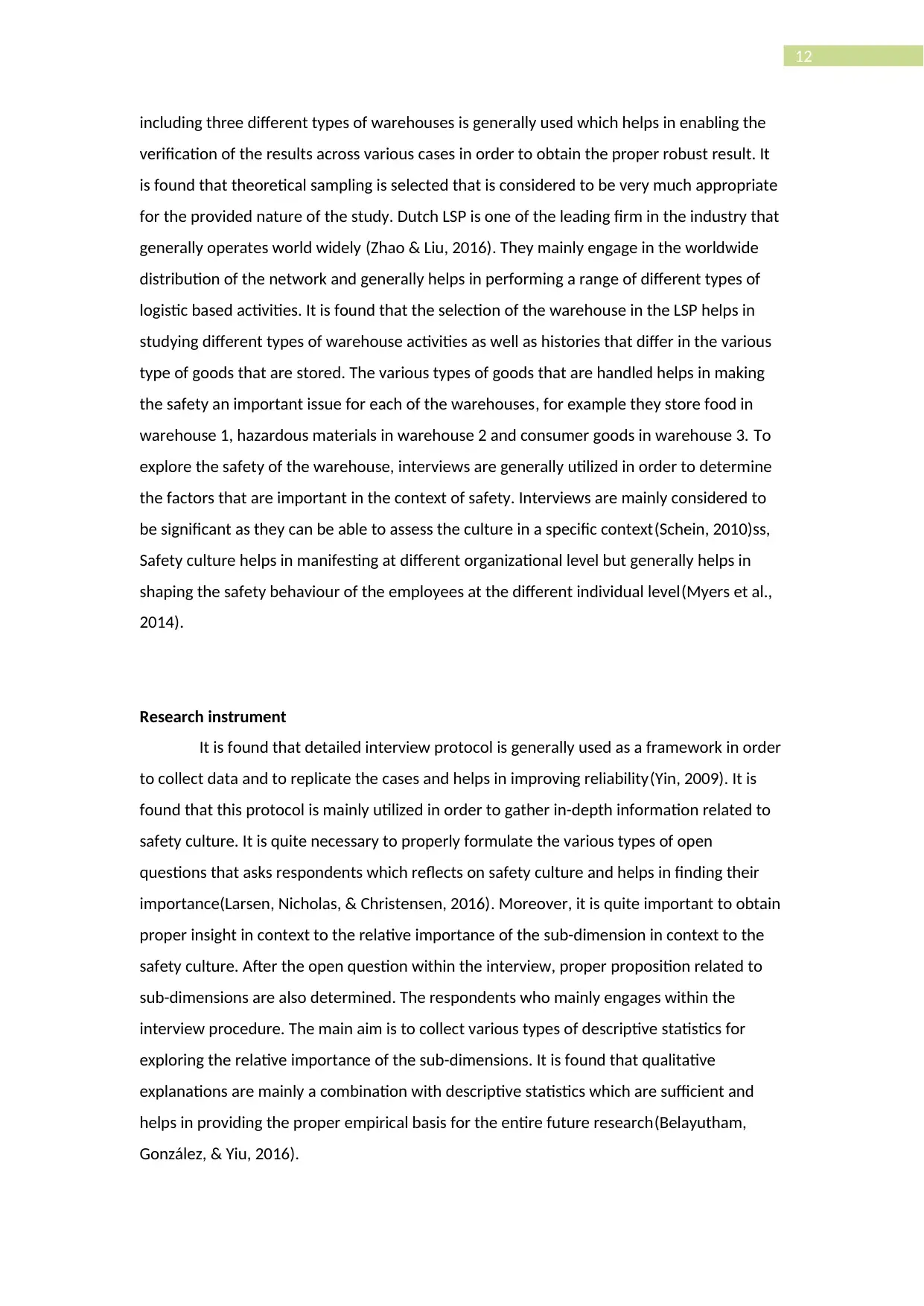
12
including three different types of warehouses is generally used which helps in enabling the
verification of the results across various cases in order to obtain the proper robust result. It
is found that theoretical sampling is selected that is considered to be very much appropriate
for the provided nature of the study. Dutch LSP is one of the leading firm in the industry that
generally operates world widely (Zhao & Liu, 2016). They mainly engage in the worldwide
distribution of the network and generally helps in performing a range of different types of
logistic based activities. It is found that the selection of the warehouse in the LSP helps in
studying different types of warehouse activities as well as histories that differ in the various
type of goods that are stored. The various types of goods that are handled helps in making
the safety an important issue for each of the warehouses, for example they store food in
warehouse 1, hazardous materials in warehouse 2 and consumer goods in warehouse 3. To
explore the safety of the warehouse, interviews are generally utilized in order to determine
the factors that are important in the context of safety. Interviews are mainly considered to
be significant as they can be able to assess the culture in a specific context(Schein, 2010)ss,
Safety culture helps in manifesting at different organizational level but generally helps in
shaping the safety behaviour of the employees at the different individual level(Myers et al.,
2014).
Research instrument
It is found that detailed interview protocol is generally used as a framework in order
to collect data and to replicate the cases and helps in improving reliability(Yin, 2009). It is
found that this protocol is mainly utilized in order to gather in-depth information related to
safety culture. It is quite necessary to properly formulate the various types of open
questions that asks respondents which reflects on safety culture and helps in finding their
importance(Larsen, Nicholas, & Christensen, 2016). Moreover, it is quite important to obtain
proper insight in context to the relative importance of the sub-dimension in context to the
safety culture. After the open question within the interview, proper proposition related to
sub-dimensions are also determined. The respondents who mainly engages within the
interview procedure. The main aim is to collect various types of descriptive statistics for
exploring the relative importance of the sub-dimensions. It is found that qualitative
explanations are mainly a combination with descriptive statistics which are sufficient and
helps in providing the proper empirical basis for the entire future research(Belayutham,
González, & Yiu, 2016).
including three different types of warehouses is generally used which helps in enabling the
verification of the results across various cases in order to obtain the proper robust result. It
is found that theoretical sampling is selected that is considered to be very much appropriate
for the provided nature of the study. Dutch LSP is one of the leading firm in the industry that
generally operates world widely (Zhao & Liu, 2016). They mainly engage in the worldwide
distribution of the network and generally helps in performing a range of different types of
logistic based activities. It is found that the selection of the warehouse in the LSP helps in
studying different types of warehouse activities as well as histories that differ in the various
type of goods that are stored. The various types of goods that are handled helps in making
the safety an important issue for each of the warehouses, for example they store food in
warehouse 1, hazardous materials in warehouse 2 and consumer goods in warehouse 3. To
explore the safety of the warehouse, interviews are generally utilized in order to determine
the factors that are important in the context of safety. Interviews are mainly considered to
be significant as they can be able to assess the culture in a specific context(Schein, 2010)ss,
Safety culture helps in manifesting at different organizational level but generally helps in
shaping the safety behaviour of the employees at the different individual level(Myers et al.,
2014).
Research instrument
It is found that detailed interview protocol is generally used as a framework in order
to collect data and to replicate the cases and helps in improving reliability(Yin, 2009). It is
found that this protocol is mainly utilized in order to gather in-depth information related to
safety culture. It is quite necessary to properly formulate the various types of open
questions that asks respondents which reflects on safety culture and helps in finding their
importance(Larsen, Nicholas, & Christensen, 2016). Moreover, it is quite important to obtain
proper insight in context to the relative importance of the sub-dimension in context to the
safety culture. After the open question within the interview, proper proposition related to
sub-dimensions are also determined. The respondents who mainly engages within the
interview procedure. The main aim is to collect various types of descriptive statistics for
exploring the relative importance of the sub-dimensions. It is found that qualitative
explanations are mainly a combination with descriptive statistics which are sufficient and
helps in providing the proper empirical basis for the entire future research(Belayutham,
González, & Yiu, 2016).
Paraphrase This Document
Need a fresh take? Get an instant paraphrase of this document with our AI Paraphraser
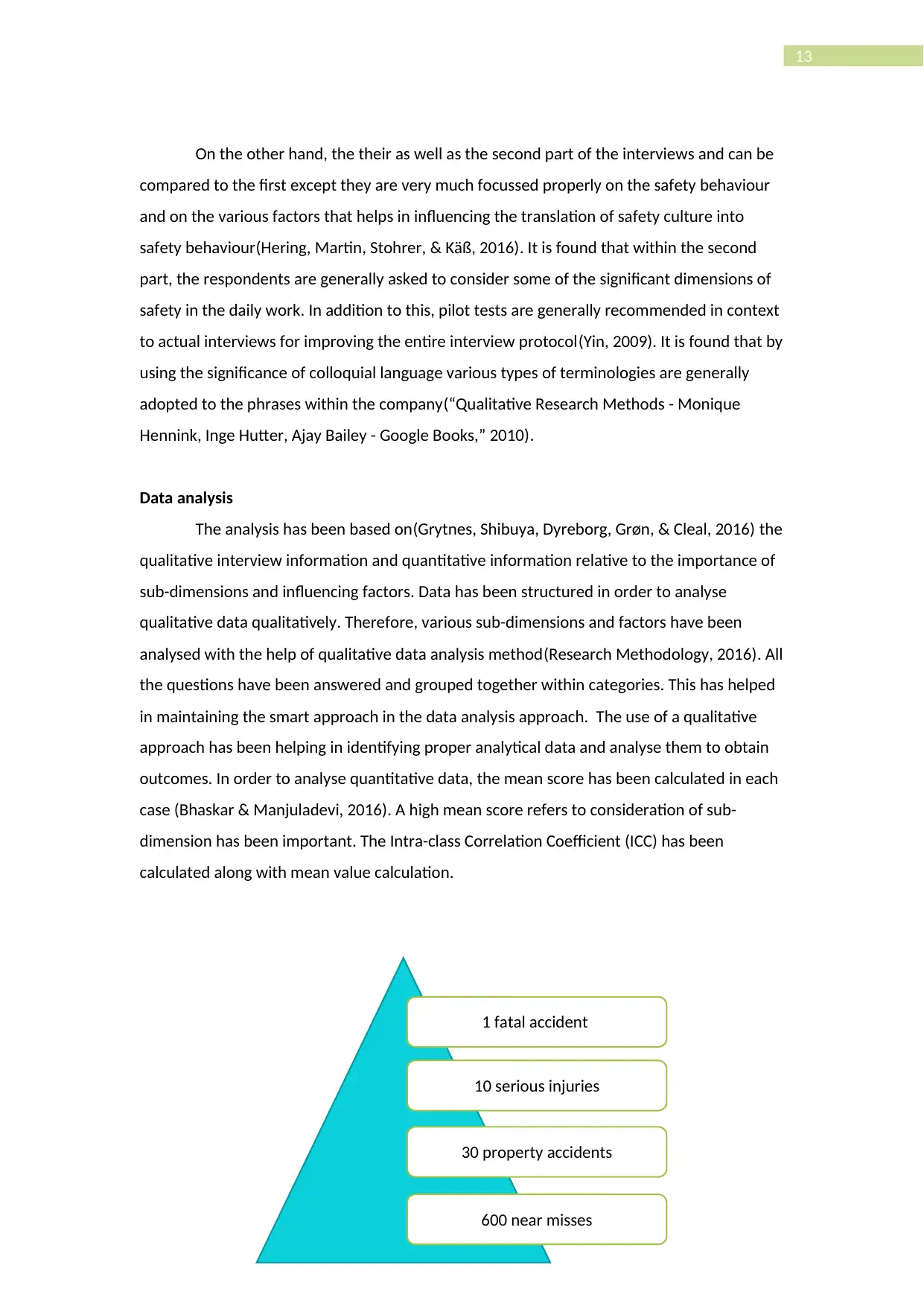
13
On the other hand, the their as well as the second part of the interviews and can be
compared to the first except they are very much focussed properly on the safety behaviour
and on the various factors that helps in influencing the translation of safety culture into
safety behaviour(Hering, Martin, Stohrer, & Käß, 2016). It is found that within the second
part, the respondents are generally asked to consider some of the significant dimensions of
safety in the daily work. In addition to this, pilot tests are generally recommended in context
to actual interviews for improving the entire interview protocol(Yin, 2009). It is found that by
using the significance of colloquial language various types of terminologies are generally
adopted to the phrases within the company(“Qualitative Research Methods - Monique
Hennink, Inge Hutter, Ajay Bailey - Google Books,” 2010).
Data analysis
The analysis has been based on(Grytnes, Shibuya, Dyreborg, Grøn, & Cleal, 2016) the
qualitative interview information and quantitative information relative to the importance of
sub-dimensions and influencing factors. Data has been structured in order to analyse
qualitative data qualitatively. Therefore, various sub-dimensions and factors have been
analysed with the help of qualitative data analysis method(Research Methodology, 2016). All
the questions have been answered and grouped together within categories. This has helped
in maintaining the smart approach in the data analysis approach. The use of a qualitative
approach has been helping in identifying proper analytical data and analyse them to obtain
outcomes. In order to analyse quantitative data, the mean score has been calculated in each
case (Bhaskar & Manjuladevi, 2016). A high mean score refers to consideration of sub-
dimension has been important. The Intra-class Correlation Coefficient (ICC) has been
calculated along with mean value calculation.
1 fatal accident
10 serious injuries
30 property accidents
600 near misses
On the other hand, the their as well as the second part of the interviews and can be
compared to the first except they are very much focussed properly on the safety behaviour
and on the various factors that helps in influencing the translation of safety culture into
safety behaviour(Hering, Martin, Stohrer, & Käß, 2016). It is found that within the second
part, the respondents are generally asked to consider some of the significant dimensions of
safety in the daily work. In addition to this, pilot tests are generally recommended in context
to actual interviews for improving the entire interview protocol(Yin, 2009). It is found that by
using the significance of colloquial language various types of terminologies are generally
adopted to the phrases within the company(“Qualitative Research Methods - Monique
Hennink, Inge Hutter, Ajay Bailey - Google Books,” 2010).
Data analysis
The analysis has been based on(Grytnes, Shibuya, Dyreborg, Grøn, & Cleal, 2016) the
qualitative interview information and quantitative information relative to the importance of
sub-dimensions and influencing factors. Data has been structured in order to analyse
qualitative data qualitatively. Therefore, various sub-dimensions and factors have been
analysed with the help of qualitative data analysis method(Research Methodology, 2016). All
the questions have been answered and grouped together within categories. This has helped
in maintaining the smart approach in the data analysis approach. The use of a qualitative
approach has been helping in identifying proper analytical data and analyse them to obtain
outcomes. In order to analyse quantitative data, the mean score has been calculated in each
case (Bhaskar & Manjuladevi, 2016). A high mean score refers to consideration of sub-
dimension has been important. The Intra-class Correlation Coefficient (ICC) has been
calculated along with mean value calculation.
1 fatal accident
10 serious injuries
30 property accidents
600 near misses
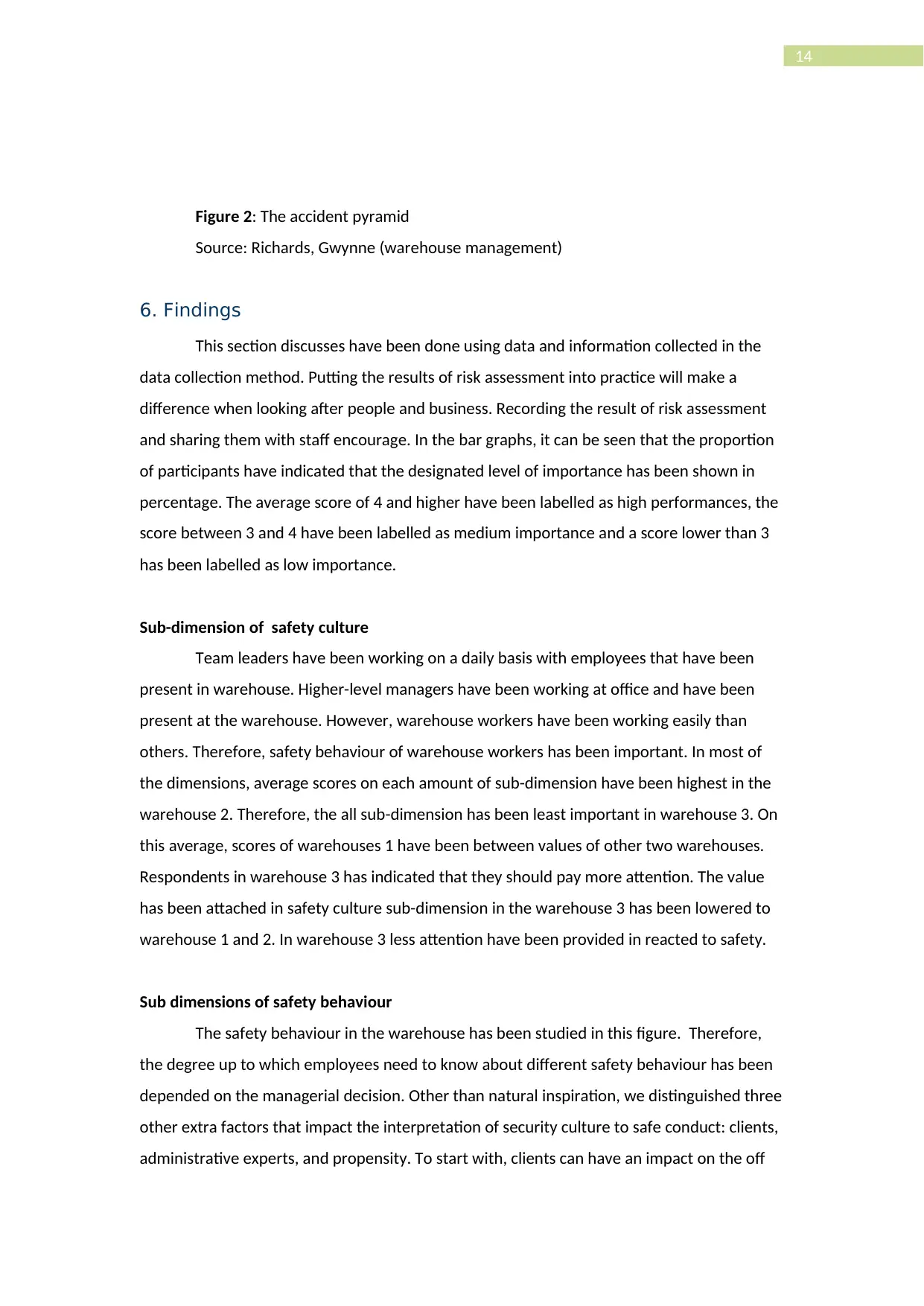
14
Figure 2: The accident pyramid
Source: Richards, Gwynne (warehouse management)
6. Findings
This section discusses have been done using data and information collected in the
data collection method. Putting the results of risk assessment into practice will make a
difference when looking after people and business. Recording the result of risk assessment
and sharing them with staff encourage. In the bar graphs, it can be seen that the proportion
of participants have indicated that the designated level of importance has been shown in
percentage. The average score of 4 and higher have been labelled as high performances, the
score between 3 and 4 have been labelled as medium importance and a score lower than 3
has been labelled as low importance.
Sub-dimension of safety culture
Team leaders have been working on a daily basis with employees that have been
present in warehouse. Higher-level managers have been working at office and have been
present at the warehouse. However, warehouse workers have been working easily than
others. Therefore, safety behaviour of warehouse workers has been important. In most of
the dimensions, average scores on each amount of sub-dimension have been highest in the
warehouse 2. Therefore, the all sub-dimension has been least important in warehouse 3. On
this average, scores of warehouses 1 have been between values of other two warehouses.
Respondents in warehouse 3 has indicated that they should pay more attention. The value
has been attached in safety culture sub-dimension in the warehouse 3 has been lowered to
warehouse 1 and 2. In warehouse 3 less attention have been provided in reacted to safety.
Sub dimensions of safety behaviour
The safety behaviour in the warehouse has been studied in this figure. Therefore,
the degree up to which employees need to know about different safety behaviour has been
depended on the managerial decision. Other than natural inspiration, we distinguished three
other extra factors that impact the interpretation of security culture to safe conduct: clients,
administrative experts, and propensity. To start with, clients can have an impact on the off
Figure 2: The accident pyramid
Source: Richards, Gwynne (warehouse management)
6. Findings
This section discusses have been done using data and information collected in the
data collection method. Putting the results of risk assessment into practice will make a
difference when looking after people and business. Recording the result of risk assessment
and sharing them with staff encourage. In the bar graphs, it can be seen that the proportion
of participants have indicated that the designated level of importance has been shown in
percentage. The average score of 4 and higher have been labelled as high performances, the
score between 3 and 4 have been labelled as medium importance and a score lower than 3
has been labelled as low importance.
Sub-dimension of safety culture
Team leaders have been working on a daily basis with employees that have been
present in warehouse. Higher-level managers have been working at office and have been
present at the warehouse. However, warehouse workers have been working easily than
others. Therefore, safety behaviour of warehouse workers has been important. In most of
the dimensions, average scores on each amount of sub-dimension have been highest in the
warehouse 2. Therefore, the all sub-dimension has been least important in warehouse 3. On
this average, scores of warehouses 1 have been between values of other two warehouses.
Respondents in warehouse 3 has indicated that they should pay more attention. The value
has been attached in safety culture sub-dimension in the warehouse 3 has been lowered to
warehouse 1 and 2. In warehouse 3 less attention have been provided in reacted to safety.
Sub dimensions of safety behaviour
The safety behaviour in the warehouse has been studied in this figure. Therefore,
the degree up to which employees need to know about different safety behaviour has been
depended on the managerial decision. Other than natural inspiration, we distinguished three
other extra factors that impact the interpretation of security culture to safe conduct: clients,
administrative experts, and propensity. To start with, clients can have an impact on the off
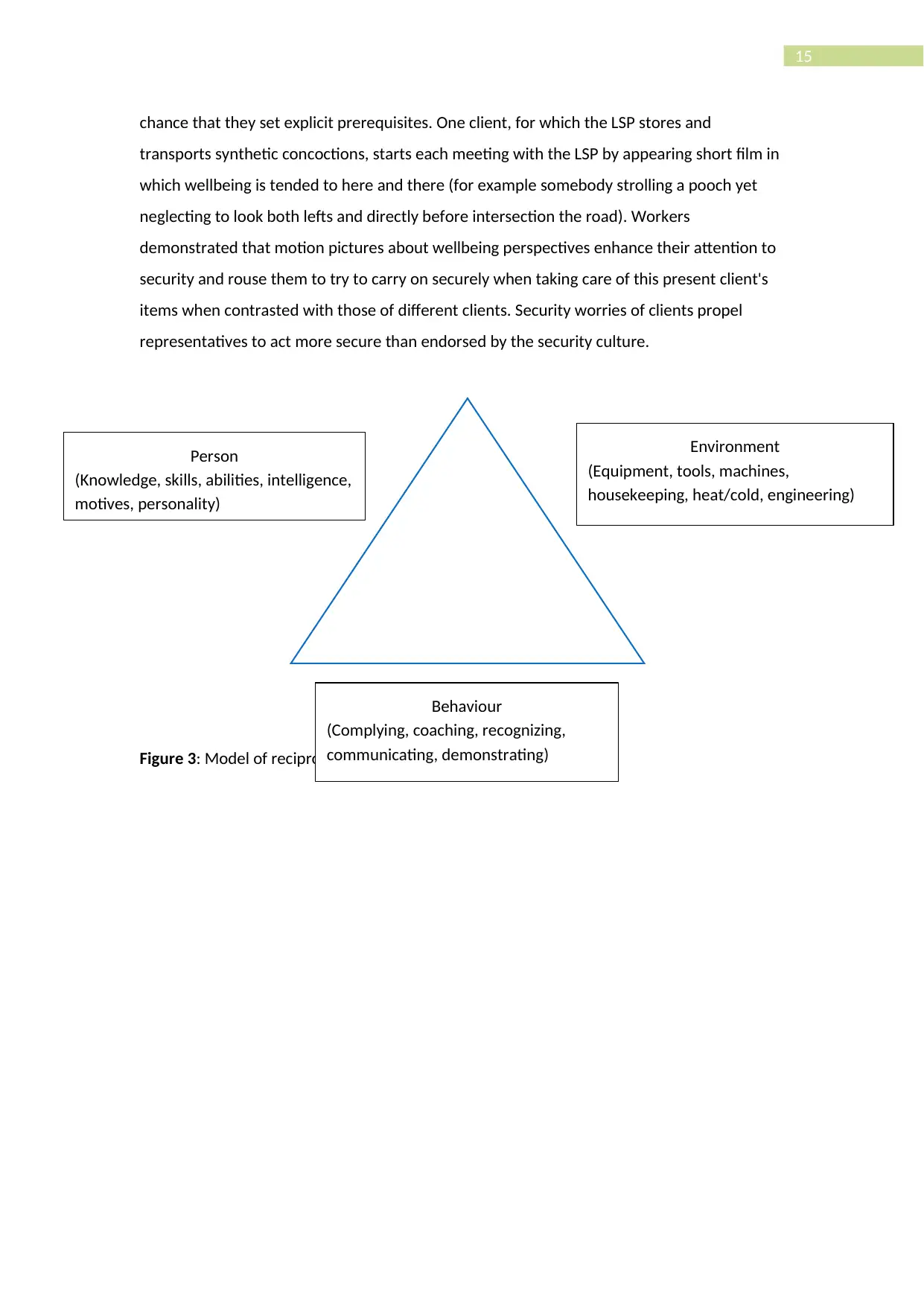
15
chance that they set explicit prerequisites. One client, for which the LSP stores and
transports synthetic concoctions, starts each meeting with the LSP by appearing short film in
which wellbeing is tended to here and there (for example somebody strolling a pooch yet
neglecting to look both lefts and directly before intersection the road). Workers
demonstrated that motion pictures about wellbeing perspectives enhance their attention to
security and rouse them to try to carry on securely when taking care of this present client's
items when contrasted with those of different clients. Security worries of clients propel
representatives to act more secure than endorsed by the security culture.
Figure 3: Model of reciprocal determinism
Person
(Knowledge, skills, abilities, intelligence,
motives, personality)
Environment
(Equipment, tools, machines,
housekeeping, heat/cold, engineering)
Behaviour
(Complying, coaching, recognizing,
communicating, demonstrating)
chance that they set explicit prerequisites. One client, for which the LSP stores and
transports synthetic concoctions, starts each meeting with the LSP by appearing short film in
which wellbeing is tended to here and there (for example somebody strolling a pooch yet
neglecting to look both lefts and directly before intersection the road). Workers
demonstrated that motion pictures about wellbeing perspectives enhance their attention to
security and rouse them to try to carry on securely when taking care of this present client's
items when contrasted with those of different clients. Security worries of clients propel
representatives to act more secure than endorsed by the security culture.
Figure 3: Model of reciprocal determinism
Person
(Knowledge, skills, abilities, intelligence,
motives, personality)
Environment
(Equipment, tools, machines,
housekeeping, heat/cold, engineering)
Behaviour
(Complying, coaching, recognizing,
communicating, demonstrating)
Secure Best Marks with AI Grader
Need help grading? Try our AI Grader for instant feedback on your assignments.

16
Intrinsic motivation
Habit
Customers
Regulatory authorities
Workload
Social status
Penalties
Promotion
Bonus
Influencing Factors
Safety Culture Safety Behaviour
People dimension Technology dimensionProcedures dimension
Team leader
Management
Stakeholders
Worker
Safety procedures
Safety markings
Expected
Comply with
Equipment
Facilities
Intrinsic motivation
Habit
Customers
Regulatory authorities
Workload
Social status
Penalties
Promotion
Bonus
Influencing Factors
Safety Culture Safety Behaviour
People dimension Technology dimensionProcedures dimension
Team leader
Management
Stakeholders
Worker
Safety procedures
Safety markings
Expected
Comply with
Equipment
Facilities
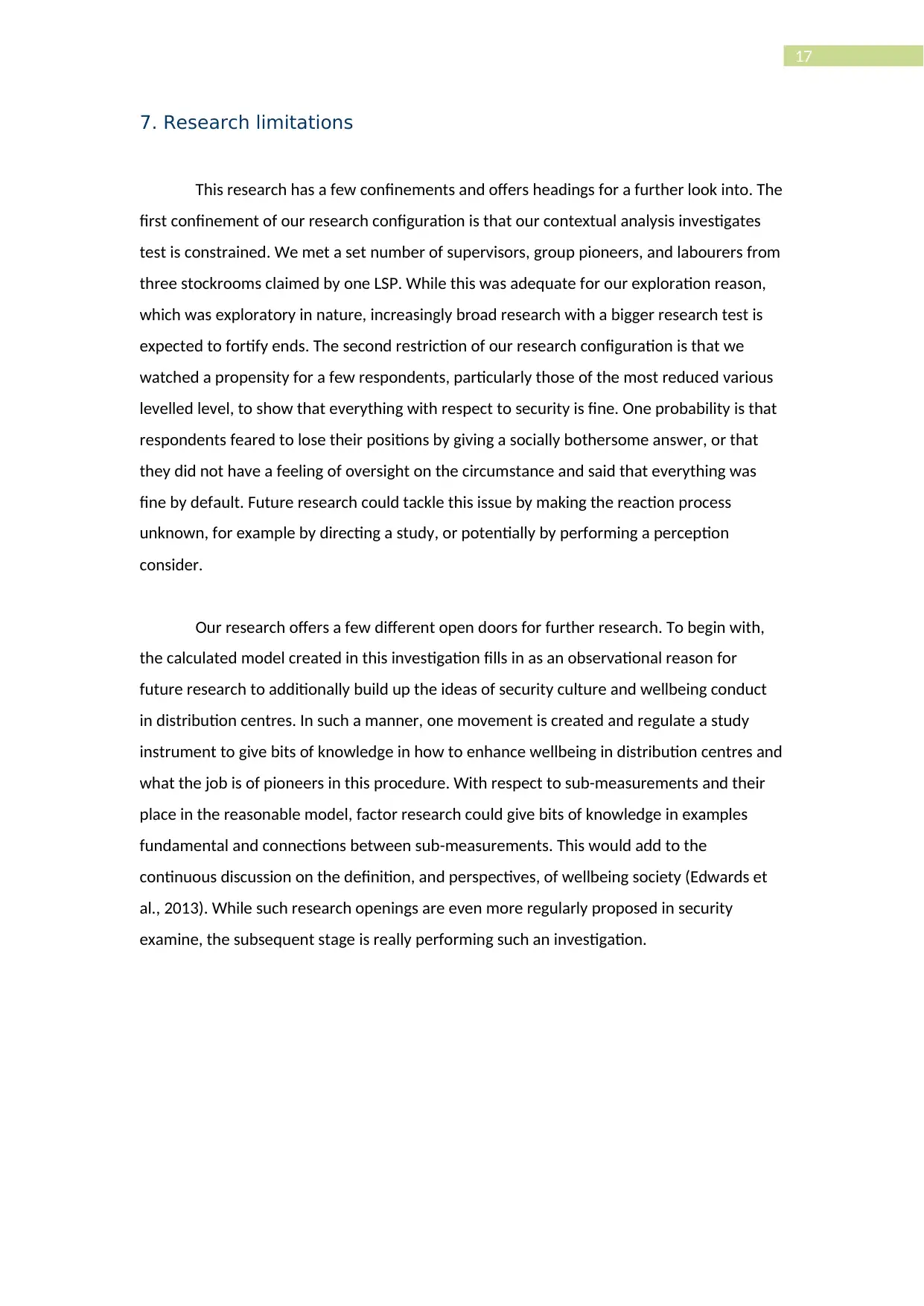
17
7. Research limitations
This research has a few confinements and offers headings for a further look into. The
first confinement of our research configuration is that our contextual analysis investigates
test is constrained. We met a set number of supervisors, group pioneers, and labourers from
three stockrooms claimed by one LSP. While this was adequate for our exploration reason,
which was exploratory in nature, increasingly broad research with a bigger research test is
expected to fortify ends. The second restriction of our research configuration is that we
watched a propensity for a few respondents, particularly those of the most reduced various
levelled level, to show that everything with respect to security is fine. One probability is that
respondents feared to lose their positions by giving a socially bothersome answer, or that
they did not have a feeling of oversight on the circumstance and said that everything was
fine by default. Future research could tackle this issue by making the reaction process
unknown, for example by directing a study, or potentially by performing a perception
consider.
Our research offers a few different open doors for further research. To begin with,
the calculated model created in this investigation fills in as an observational reason for
future research to additionally build up the ideas of security culture and wellbeing conduct
in distribution centres. In such a manner, one movement is created and regulate a study
instrument to give bits of knowledge in how to enhance wellbeing in distribution centres and
what the job is of pioneers in this procedure. With respect to sub-measurements and their
place in the reasonable model, factor research could give bits of knowledge in examples
fundamental and connections between sub-measurements. This would add to the
continuous discussion on the definition, and perspectives, of wellbeing society (Edwards et
al., 2013). While such research openings are even more regularly proposed in security
examine, the subsequent stage is really performing such an investigation.
7. Research limitations
This research has a few confinements and offers headings for a further look into. The
first confinement of our research configuration is that our contextual analysis investigates
test is constrained. We met a set number of supervisors, group pioneers, and labourers from
three stockrooms claimed by one LSP. While this was adequate for our exploration reason,
which was exploratory in nature, increasingly broad research with a bigger research test is
expected to fortify ends. The second restriction of our research configuration is that we
watched a propensity for a few respondents, particularly those of the most reduced various
levelled level, to show that everything with respect to security is fine. One probability is that
respondents feared to lose their positions by giving a socially bothersome answer, or that
they did not have a feeling of oversight on the circumstance and said that everything was
fine by default. Future research could tackle this issue by making the reaction process
unknown, for example by directing a study, or potentially by performing a perception
consider.
Our research offers a few different open doors for further research. To begin with,
the calculated model created in this investigation fills in as an observational reason for
future research to additionally build up the ideas of security culture and wellbeing conduct
in distribution centres. In such a manner, one movement is created and regulate a study
instrument to give bits of knowledge in how to enhance wellbeing in distribution centres and
what the job is of pioneers in this procedure. With respect to sub-measurements and their
place in the reasonable model, factor research could give bits of knowledge in examples
fundamental and connections between sub-measurements. This would add to the
continuous discussion on the definition, and perspectives, of wellbeing society (Edwards et
al., 2013). While such research openings are even more regularly proposed in security
examine, the subsequent stage is really performing such an investigation.
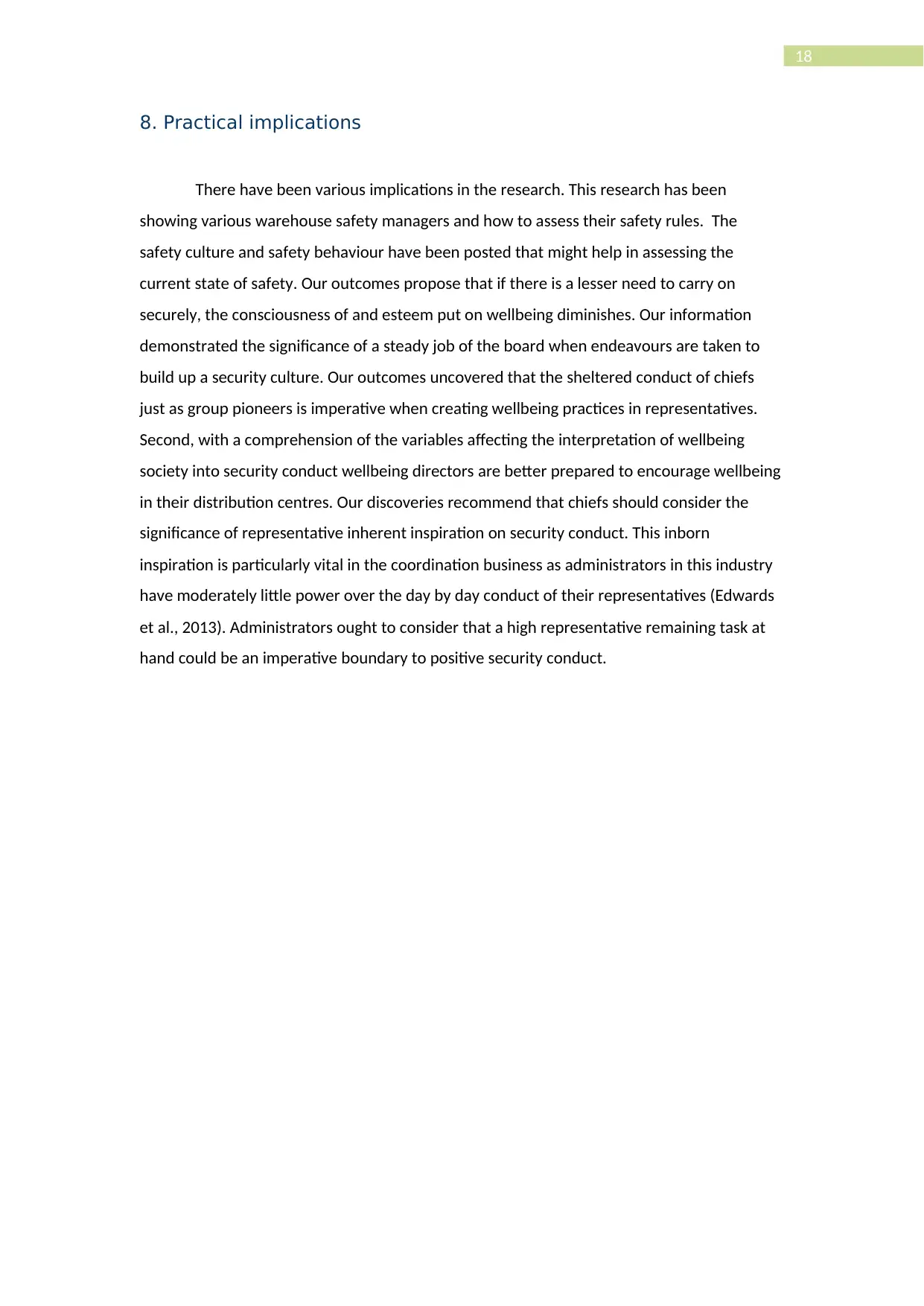
18
8. Practical implications
There have been various implications in the research. This research has been
showing various warehouse safety managers and how to assess their safety rules. The
safety culture and safety behaviour have been posted that might help in assessing the
current state of safety. Our outcomes propose that if there is a lesser need to carry on
securely, the consciousness of and esteem put on wellbeing diminishes. Our information
demonstrated the significance of a steady job of the board when endeavours are taken to
build up a security culture. Our outcomes uncovered that the sheltered conduct of chiefs
just as group pioneers is imperative when creating wellbeing practices in representatives.
Second, with a comprehension of the variables affecting the interpretation of wellbeing
society into security conduct wellbeing directors are better prepared to encourage wellbeing
in their distribution centres. Our discoveries recommend that chiefs should consider the
significance of representative inherent inspiration on security conduct. This inborn
inspiration is particularly vital in the coordination business as administrators in this industry
have moderately little power over the day by day conduct of their representatives (Edwards
et al., 2013). Administrators ought to consider that a high representative remaining task at
hand could be an imperative boundary to positive security conduct.
8. Practical implications
There have been various implications in the research. This research has been
showing various warehouse safety managers and how to assess their safety rules. The
safety culture and safety behaviour have been posted that might help in assessing the
current state of safety. Our outcomes propose that if there is a lesser need to carry on
securely, the consciousness of and esteem put on wellbeing diminishes. Our information
demonstrated the significance of a steady job of the board when endeavours are taken to
build up a security culture. Our outcomes uncovered that the sheltered conduct of chiefs
just as group pioneers is imperative when creating wellbeing practices in representatives.
Second, with a comprehension of the variables affecting the interpretation of wellbeing
society into security conduct wellbeing directors are better prepared to encourage wellbeing
in their distribution centres. Our discoveries recommend that chiefs should consider the
significance of representative inherent inspiration on security conduct. This inborn
inspiration is particularly vital in the coordination business as administrators in this industry
have moderately little power over the day by day conduct of their representatives (Edwards
et al., 2013). Administrators ought to consider that a high representative remaining task at
hand could be an imperative boundary to positive security conduct.
Paraphrase This Document
Need a fresh take? Get an instant paraphrase of this document with our AI Paraphraser
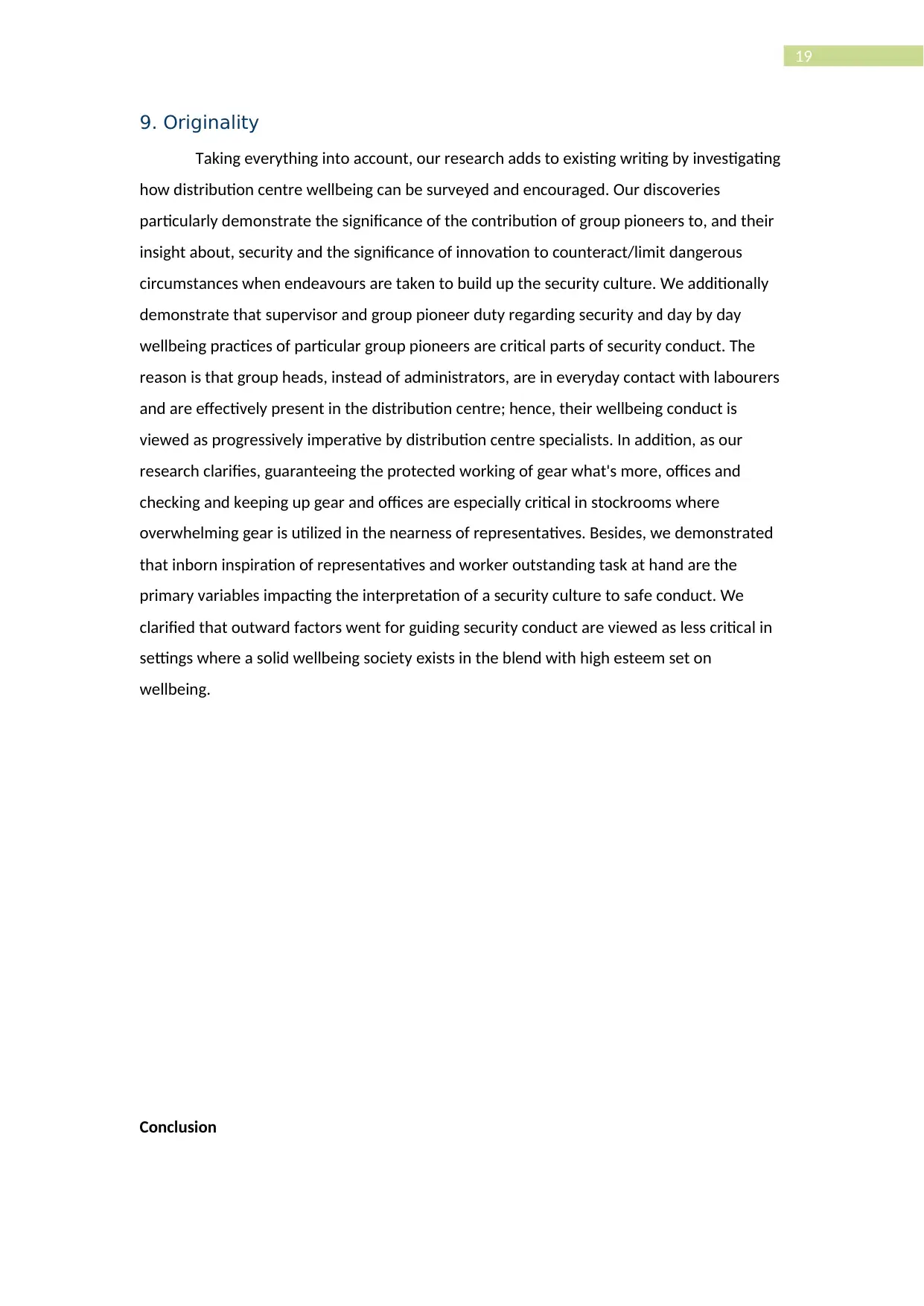
19
9. Originality
Taking everything into account, our research adds to existing writing by investigating
how distribution centre wellbeing can be surveyed and encouraged. Our discoveries
particularly demonstrate the significance of the contribution of group pioneers to, and their
insight about, security and the significance of innovation to counteract/limit dangerous
circumstances when endeavours are taken to build up the security culture. We additionally
demonstrate that supervisor and group pioneer duty regarding security and day by day
wellbeing practices of particular group pioneers are critical parts of security conduct. The
reason is that group heads, instead of administrators, are in everyday contact with labourers
and are effectively present in the distribution centre; hence, their wellbeing conduct is
viewed as progressively imperative by distribution centre specialists. In addition, as our
research clarifies, guaranteeing the protected working of gear what's more, offices and
checking and keeping up gear and offices are especially critical in stockrooms where
overwhelming gear is utilized in the nearness of representatives. Besides, we demonstrated
that inborn inspiration of representatives and worker outstanding task at hand are the
primary variables impacting the interpretation of a security culture to safe conduct. We
clarified that outward factors went for guiding security conduct are viewed as less critical in
settings where a solid wellbeing society exists in the blend with high esteem set on
wellbeing.
Conclusion
9. Originality
Taking everything into account, our research adds to existing writing by investigating
how distribution centre wellbeing can be surveyed and encouraged. Our discoveries
particularly demonstrate the significance of the contribution of group pioneers to, and their
insight about, security and the significance of innovation to counteract/limit dangerous
circumstances when endeavours are taken to build up the security culture. We additionally
demonstrate that supervisor and group pioneer duty regarding security and day by day
wellbeing practices of particular group pioneers are critical parts of security conduct. The
reason is that group heads, instead of administrators, are in everyday contact with labourers
and are effectively present in the distribution centre; hence, their wellbeing conduct is
viewed as progressively imperative by distribution centre specialists. In addition, as our
research clarifies, guaranteeing the protected working of gear what's more, offices and
checking and keeping up gear and offices are especially critical in stockrooms where
overwhelming gear is utilized in the nearness of representatives. Besides, we demonstrated
that inborn inspiration of representatives and worker outstanding task at hand are the
primary variables impacting the interpretation of a security culture to safe conduct. We
clarified that outward factors went for guiding security conduct are viewed as less critical in
settings where a solid wellbeing society exists in the blend with high esteem set on
wellbeing.
Conclusion
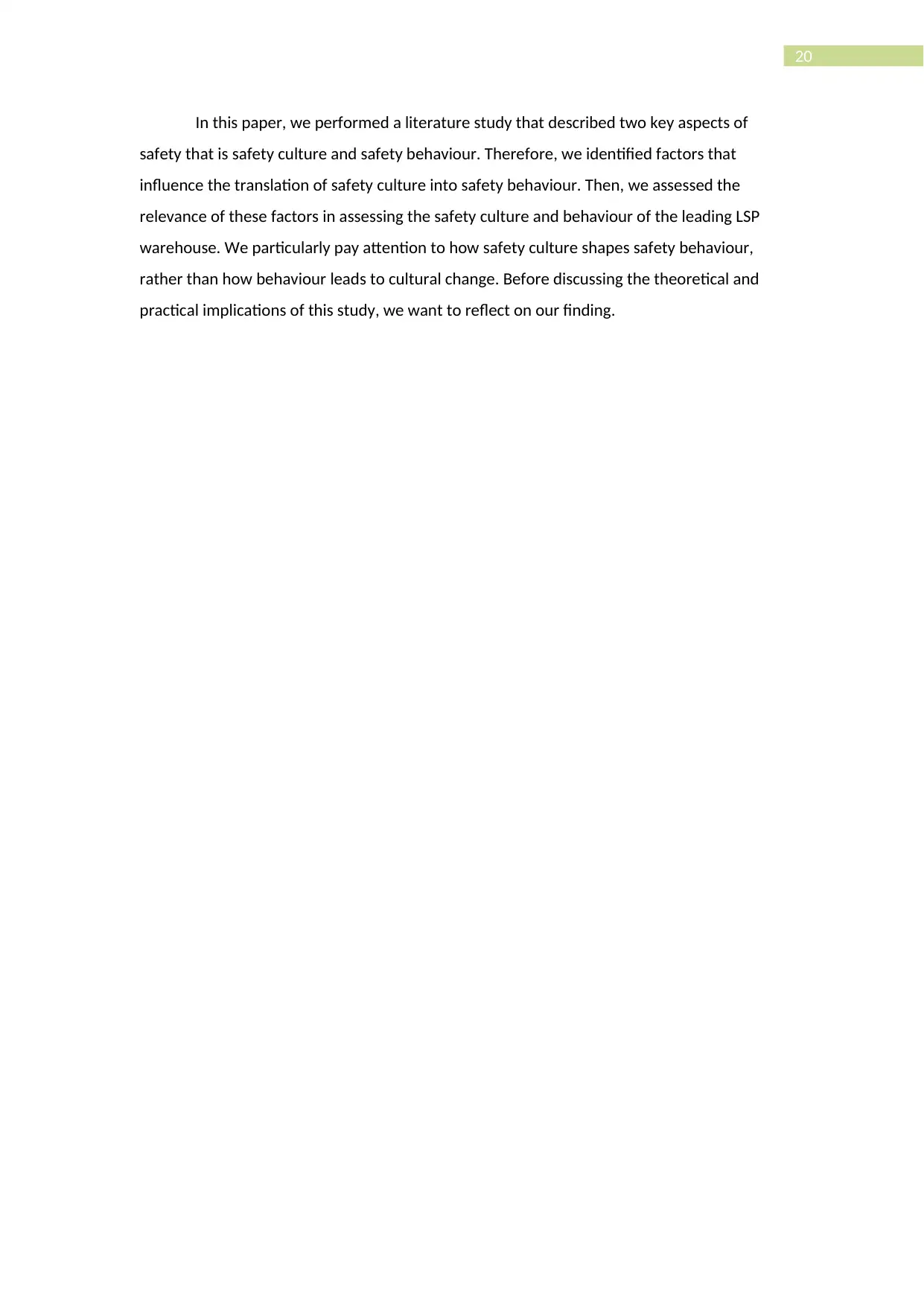
20
In this paper, we performed a literature study that described two key aspects of
safety that is safety culture and safety behaviour. Therefore, we identified factors that
influence the translation of safety culture into safety behaviour. Then, we assessed the
relevance of these factors in assessing the safety culture and behaviour of the leading LSP
warehouse. We particularly pay attention to how safety culture shapes safety behaviour,
rather than how behaviour leads to cultural change. Before discussing the theoretical and
practical implications of this study, we want to reflect on our finding.
In this paper, we performed a literature study that described two key aspects of
safety that is safety culture and safety behaviour. Therefore, we identified factors that
influence the translation of safety culture into safety behaviour. Then, we assessed the
relevance of these factors in assessing the safety culture and behaviour of the leading LSP
warehouse. We particularly pay attention to how safety culture shapes safety behaviour,
rather than how behaviour leads to cultural change. Before discussing the theoretical and
practical implications of this study, we want to reflect on our finding.
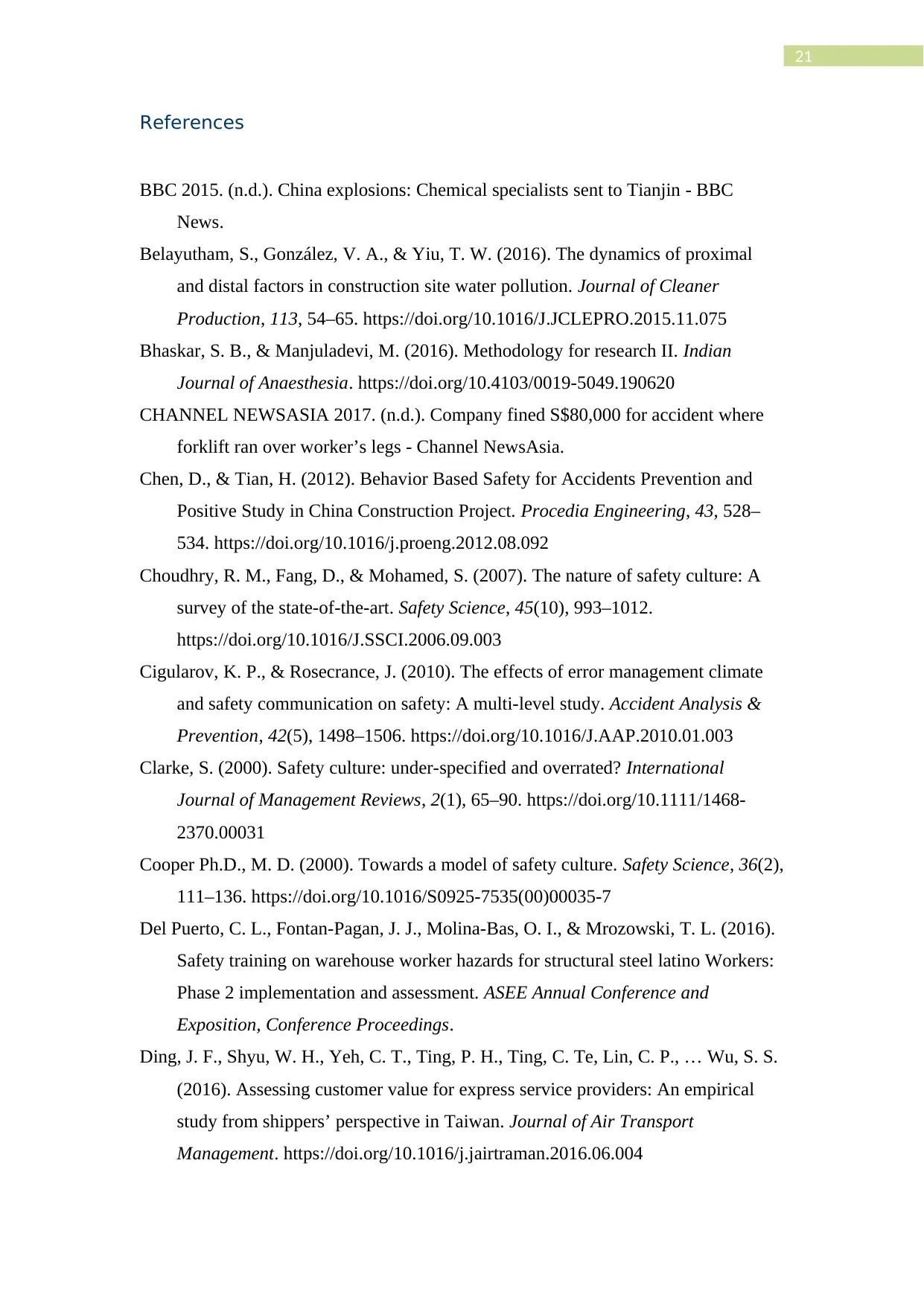
21
References
BBC 2015. (n.d.). China explosions: Chemical specialists sent to Tianjin - BBC
News.
Belayutham, S., González, V. A., & Yiu, T. W. (2016). The dynamics of proximal
and distal factors in construction site water pollution. Journal of Cleaner
Production, 113, 54–65. https://doi.org/10.1016/J.JCLEPRO.2015.11.075
Bhaskar, S. B., & Manjuladevi, M. (2016). Methodology for research II. Indian
Journal of Anaesthesia. https://doi.org/10.4103/0019-5049.190620
CHANNEL NEWSASIA 2017. (n.d.). Company fined S$80,000 for accident where
forklift ran over worker’s legs - Channel NewsAsia.
Chen, D., & Tian, H. (2012). Behavior Based Safety for Accidents Prevention and
Positive Study in China Construction Project. Procedia Engineering, 43, 528–
534. https://doi.org/10.1016/j.proeng.2012.08.092
Choudhry, R. M., Fang, D., & Mohamed, S. (2007). The nature of safety culture: A
survey of the state-of-the-art. Safety Science, 45(10), 993–1012.
https://doi.org/10.1016/J.SSCI.2006.09.003
Cigularov, K. P., & Rosecrance, J. (2010). The effects of error management climate
and safety communication on safety: A multi-level study. Accident Analysis &
Prevention, 42(5), 1498–1506. https://doi.org/10.1016/J.AAP.2010.01.003
Clarke, S. (2000). Safety culture: under-specified and overrated? International
Journal of Management Reviews, 2(1), 65–90. https://doi.org/10.1111/1468-
2370.00031
Cooper Ph.D., M. D. (2000). Towards a model of safety culture. Safety Science, 36(2),
111–136. https://doi.org/10.1016/S0925-7535(00)00035-7
Del Puerto, C. L., Fontan-Pagan, J. J., Molina-Bas, O. I., & Mrozowski, T. L. (2016).
Safety training on warehouse worker hazards for structural steel latino Workers:
Phase 2 implementation and assessment. ASEE Annual Conference and
Exposition, Conference Proceedings.
Ding, J. F., Shyu, W. H., Yeh, C. T., Ting, P. H., Ting, C. Te, Lin, C. P., … Wu, S. S.
(2016). Assessing customer value for express service providers: An empirical
study from shippers’ perspective in Taiwan. Journal of Air Transport
Management. https://doi.org/10.1016/j.jairtraman.2016.06.004
References
BBC 2015. (n.d.). China explosions: Chemical specialists sent to Tianjin - BBC
News.
Belayutham, S., González, V. A., & Yiu, T. W. (2016). The dynamics of proximal
and distal factors in construction site water pollution. Journal of Cleaner
Production, 113, 54–65. https://doi.org/10.1016/J.JCLEPRO.2015.11.075
Bhaskar, S. B., & Manjuladevi, M. (2016). Methodology for research II. Indian
Journal of Anaesthesia. https://doi.org/10.4103/0019-5049.190620
CHANNEL NEWSASIA 2017. (n.d.). Company fined S$80,000 for accident where
forklift ran over worker’s legs - Channel NewsAsia.
Chen, D., & Tian, H. (2012). Behavior Based Safety for Accidents Prevention and
Positive Study in China Construction Project. Procedia Engineering, 43, 528–
534. https://doi.org/10.1016/j.proeng.2012.08.092
Choudhry, R. M., Fang, D., & Mohamed, S. (2007). The nature of safety culture: A
survey of the state-of-the-art. Safety Science, 45(10), 993–1012.
https://doi.org/10.1016/J.SSCI.2006.09.003
Cigularov, K. P., & Rosecrance, J. (2010). The effects of error management climate
and safety communication on safety: A multi-level study. Accident Analysis &
Prevention, 42(5), 1498–1506. https://doi.org/10.1016/J.AAP.2010.01.003
Clarke, S. (2000). Safety culture: under-specified and overrated? International
Journal of Management Reviews, 2(1), 65–90. https://doi.org/10.1111/1468-
2370.00031
Cooper Ph.D., M. D. (2000). Towards a model of safety culture. Safety Science, 36(2),
111–136. https://doi.org/10.1016/S0925-7535(00)00035-7
Del Puerto, C. L., Fontan-Pagan, J. J., Molina-Bas, O. I., & Mrozowski, T. L. (2016).
Safety training on warehouse worker hazards for structural steel latino Workers:
Phase 2 implementation and assessment. ASEE Annual Conference and
Exposition, Conference Proceedings.
Ding, J. F., Shyu, W. H., Yeh, C. T., Ting, P. H., Ting, C. Te, Lin, C. P., … Wu, S. S.
(2016). Assessing customer value for express service providers: An empirical
study from shippers’ perspective in Taiwan. Journal of Air Transport
Management. https://doi.org/10.1016/j.jairtraman.2016.06.004
Secure Best Marks with AI Grader
Need help grading? Try our AI Grader for instant feedback on your assignments.
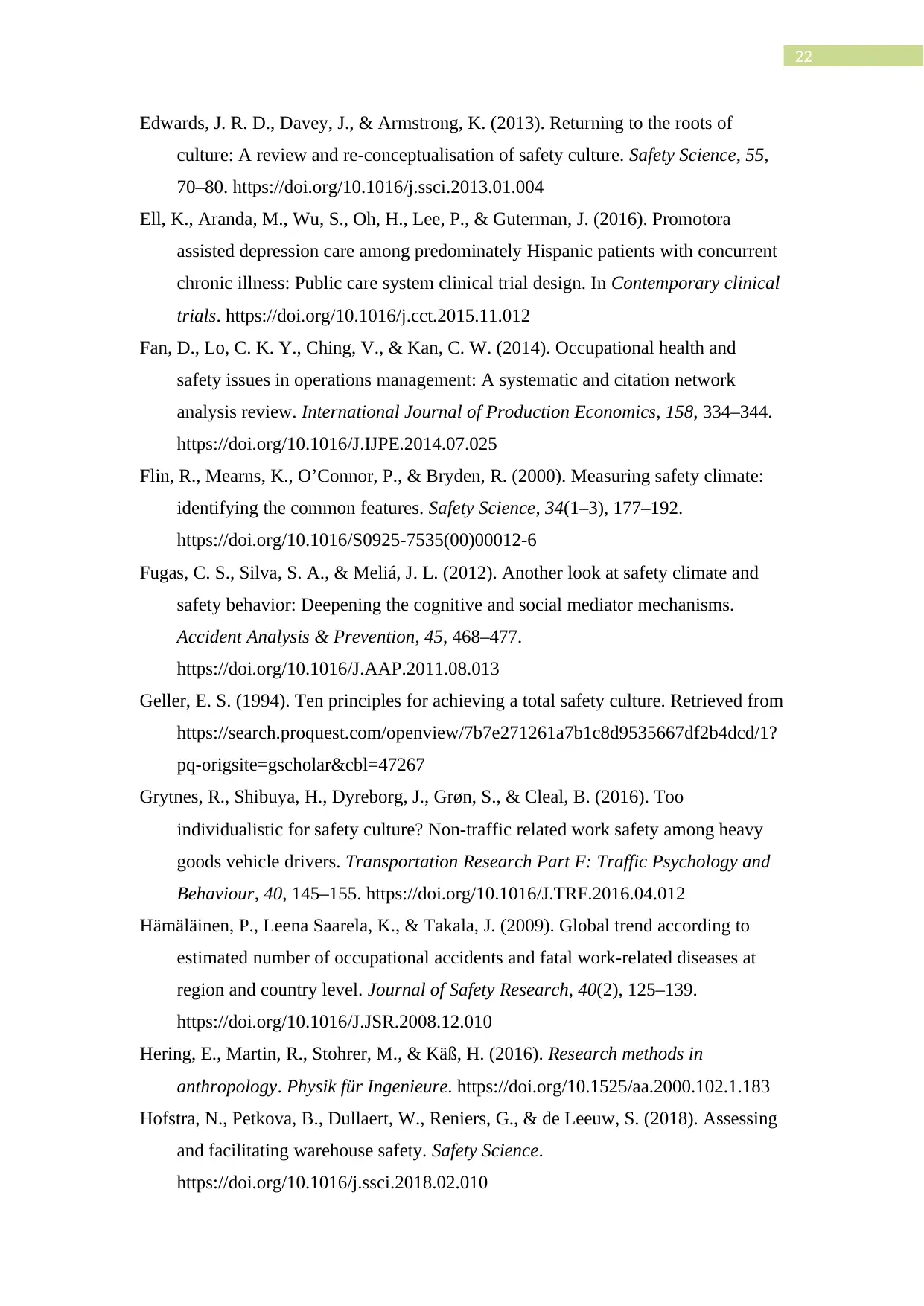
22
Edwards, J. R. D., Davey, J., & Armstrong, K. (2013). Returning to the roots of
culture: A review and re-conceptualisation of safety culture. Safety Science, 55,
70–80. https://doi.org/10.1016/j.ssci.2013.01.004
Ell, K., Aranda, M., Wu, S., Oh, H., Lee, P., & Guterman, J. (2016). Promotora
assisted depression care among predominately Hispanic patients with concurrent
chronic illness: Public care system clinical trial design. In Contemporary clinical
trials. https://doi.org/10.1016/j.cct.2015.11.012
Fan, D., Lo, C. K. Y., Ching, V., & Kan, C. W. (2014). Occupational health and
safety issues in operations management: A systematic and citation network
analysis review. International Journal of Production Economics, 158, 334–344.
https://doi.org/10.1016/J.IJPE.2014.07.025
Flin, R., Mearns, K., O’Connor, P., & Bryden, R. (2000). Measuring safety climate:
identifying the common features. Safety Science, 34(1–3), 177–192.
https://doi.org/10.1016/S0925-7535(00)00012-6
Fugas, C. S., Silva, S. A., & Meliá, J. L. (2012). Another look at safety climate and
safety behavior: Deepening the cognitive and social mediator mechanisms.
Accident Analysis & Prevention, 45, 468–477.
https://doi.org/10.1016/J.AAP.2011.08.013
Geller, E. S. (1994). Ten principles for achieving a total safety culture. Retrieved from
https://search.proquest.com/openview/7b7e271261a7b1c8d9535667df2b4dcd/1?
pq-origsite=gscholar&cbl=47267
Grytnes, R., Shibuya, H., Dyreborg, J., Grøn, S., & Cleal, B. (2016). Too
individualistic for safety culture? Non-traffic related work safety among heavy
goods vehicle drivers. Transportation Research Part F: Traffic Psychology and
Behaviour, 40, 145–155. https://doi.org/10.1016/J.TRF.2016.04.012
Hämäläinen, P., Leena Saarela, K., & Takala, J. (2009). Global trend according to
estimated number of occupational accidents and fatal work-related diseases at
region and country level. Journal of Safety Research, 40(2), 125–139.
https://doi.org/10.1016/J.JSR.2008.12.010
Hering, E., Martin, R., Stohrer, M., & Käß, H. (2016). Research methods in
anthropology. Physik für Ingenieure. https://doi.org/10.1525/aa.2000.102.1.183
Hofstra, N., Petkova, B., Dullaert, W., Reniers, G., & de Leeuw, S. (2018). Assessing
and facilitating warehouse safety. Safety Science.
https://doi.org/10.1016/j.ssci.2018.02.010
Edwards, J. R. D., Davey, J., & Armstrong, K. (2013). Returning to the roots of
culture: A review and re-conceptualisation of safety culture. Safety Science, 55,
70–80. https://doi.org/10.1016/j.ssci.2013.01.004
Ell, K., Aranda, M., Wu, S., Oh, H., Lee, P., & Guterman, J. (2016). Promotora
assisted depression care among predominately Hispanic patients with concurrent
chronic illness: Public care system clinical trial design. In Contemporary clinical
trials. https://doi.org/10.1016/j.cct.2015.11.012
Fan, D., Lo, C. K. Y., Ching, V., & Kan, C. W. (2014). Occupational health and
safety issues in operations management: A systematic and citation network
analysis review. International Journal of Production Economics, 158, 334–344.
https://doi.org/10.1016/J.IJPE.2014.07.025
Flin, R., Mearns, K., O’Connor, P., & Bryden, R. (2000). Measuring safety climate:
identifying the common features. Safety Science, 34(1–3), 177–192.
https://doi.org/10.1016/S0925-7535(00)00012-6
Fugas, C. S., Silva, S. A., & Meliá, J. L. (2012). Another look at safety climate and
safety behavior: Deepening the cognitive and social mediator mechanisms.
Accident Analysis & Prevention, 45, 468–477.
https://doi.org/10.1016/J.AAP.2011.08.013
Geller, E. S. (1994). Ten principles for achieving a total safety culture. Retrieved from
https://search.proquest.com/openview/7b7e271261a7b1c8d9535667df2b4dcd/1?
pq-origsite=gscholar&cbl=47267
Grytnes, R., Shibuya, H., Dyreborg, J., Grøn, S., & Cleal, B. (2016). Too
individualistic for safety culture? Non-traffic related work safety among heavy
goods vehicle drivers. Transportation Research Part F: Traffic Psychology and
Behaviour, 40, 145–155. https://doi.org/10.1016/J.TRF.2016.04.012
Hämäläinen, P., Leena Saarela, K., & Takala, J. (2009). Global trend according to
estimated number of occupational accidents and fatal work-related diseases at
region and country level. Journal of Safety Research, 40(2), 125–139.
https://doi.org/10.1016/J.JSR.2008.12.010
Hering, E., Martin, R., Stohrer, M., & Käß, H. (2016). Research methods in
anthropology. Physik für Ingenieure. https://doi.org/10.1525/aa.2000.102.1.183
Hofstra, N., Petkova, B., Dullaert, W., Reniers, G., & de Leeuw, S. (2018). Assessing
and facilitating warehouse safety. Safety Science.
https://doi.org/10.1016/j.ssci.2018.02.010
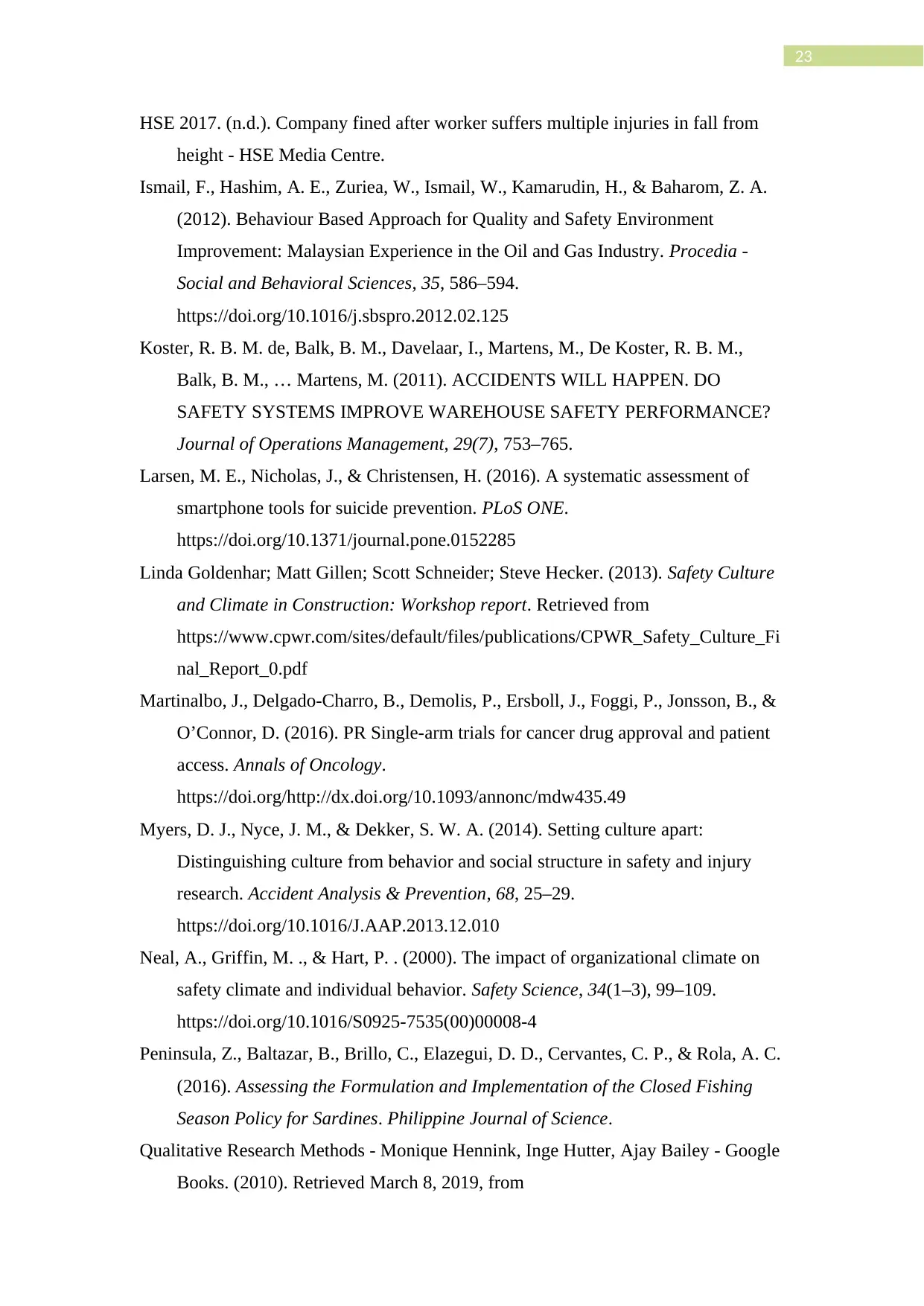
23
HSE 2017. (n.d.). Company fined after worker suffers multiple injuries in fall from
height - HSE Media Centre.
Ismail, F., Hashim, A. E., Zuriea, W., Ismail, W., Kamarudin, H., & Baharom, Z. A.
(2012). Behaviour Based Approach for Quality and Safety Environment
Improvement: Malaysian Experience in the Oil and Gas Industry. Procedia -
Social and Behavioral Sciences, 35, 586–594.
https://doi.org/10.1016/j.sbspro.2012.02.125
Koster, R. B. M. de, Balk, B. M., Davelaar, I., Martens, M., De Koster, R. B. M.,
Balk, B. M., … Martens, M. (2011). ACCIDENTS WILL HAPPEN. DO
SAFETY SYSTEMS IMPROVE WAREHOUSE SAFETY PERFORMANCE?
Journal of Operations Management, 29(7), 753–765.
Larsen, M. E., Nicholas, J., & Christensen, H. (2016). A systematic assessment of
smartphone tools for suicide prevention. PLoS ONE.
https://doi.org/10.1371/journal.pone.0152285
Linda Goldenhar; Matt Gillen; Scott Schneider; Steve Hecker. (2013). Safety Culture
and Climate in Construction: Workshop report. Retrieved from
https://www.cpwr.com/sites/default/files/publications/CPWR_Safety_Culture_Fi
nal_Report_0.pdf
Martinalbo, J., Delgado-Charro, B., Demolis, P., Ersboll, J., Foggi, P., Jonsson, B., &
O’Connor, D. (2016). PR Single-arm trials for cancer drug approval and patient
access. Annals of Oncology.
https://doi.org/http://dx.doi.org/10.1093/annonc/mdw435.49
Myers, D. J., Nyce, J. M., & Dekker, S. W. A. (2014). Setting culture apart:
Distinguishing culture from behavior and social structure in safety and injury
research. Accident Analysis & Prevention, 68, 25–29.
https://doi.org/10.1016/J.AAP.2013.12.010
Neal, A., Griffin, M. ., & Hart, P. . (2000). The impact of organizational climate on
safety climate and individual behavior. Safety Science, 34(1–3), 99–109.
https://doi.org/10.1016/S0925-7535(00)00008-4
Peninsula, Z., Baltazar, B., Brillo, C., Elazegui, D. D., Cervantes, C. P., & Rola, A. C.
(2016). Assessing the Formulation and Implementation of the Closed Fishing
Season Policy for Sardines. Philippine Journal of Science.
Qualitative Research Methods - Monique Hennink, Inge Hutter, Ajay Bailey - Google
Books. (2010). Retrieved March 8, 2019, from
HSE 2017. (n.d.). Company fined after worker suffers multiple injuries in fall from
height - HSE Media Centre.
Ismail, F., Hashim, A. E., Zuriea, W., Ismail, W., Kamarudin, H., & Baharom, Z. A.
(2012). Behaviour Based Approach for Quality and Safety Environment
Improvement: Malaysian Experience in the Oil and Gas Industry. Procedia -
Social and Behavioral Sciences, 35, 586–594.
https://doi.org/10.1016/j.sbspro.2012.02.125
Koster, R. B. M. de, Balk, B. M., Davelaar, I., Martens, M., De Koster, R. B. M.,
Balk, B. M., … Martens, M. (2011). ACCIDENTS WILL HAPPEN. DO
SAFETY SYSTEMS IMPROVE WAREHOUSE SAFETY PERFORMANCE?
Journal of Operations Management, 29(7), 753–765.
Larsen, M. E., Nicholas, J., & Christensen, H. (2016). A systematic assessment of
smartphone tools for suicide prevention. PLoS ONE.
https://doi.org/10.1371/journal.pone.0152285
Linda Goldenhar; Matt Gillen; Scott Schneider; Steve Hecker. (2013). Safety Culture
and Climate in Construction: Workshop report. Retrieved from
https://www.cpwr.com/sites/default/files/publications/CPWR_Safety_Culture_Fi
nal_Report_0.pdf
Martinalbo, J., Delgado-Charro, B., Demolis, P., Ersboll, J., Foggi, P., Jonsson, B., &
O’Connor, D. (2016). PR Single-arm trials for cancer drug approval and patient
access. Annals of Oncology.
https://doi.org/http://dx.doi.org/10.1093/annonc/mdw435.49
Myers, D. J., Nyce, J. M., & Dekker, S. W. A. (2014). Setting culture apart:
Distinguishing culture from behavior and social structure in safety and injury
research. Accident Analysis & Prevention, 68, 25–29.
https://doi.org/10.1016/J.AAP.2013.12.010
Neal, A., Griffin, M. ., & Hart, P. . (2000). The impact of organizational climate on
safety climate and individual behavior. Safety Science, 34(1–3), 99–109.
https://doi.org/10.1016/S0925-7535(00)00008-4
Peninsula, Z., Baltazar, B., Brillo, C., Elazegui, D. D., Cervantes, C. P., & Rola, A. C.
(2016). Assessing the Formulation and Implementation of the Closed Fishing
Season Policy for Sardines. Philippine Journal of Science.
Qualitative Research Methods - Monique Hennink, Inge Hutter, Ajay Bailey - Google
Books. (2010). Retrieved March 8, 2019, from
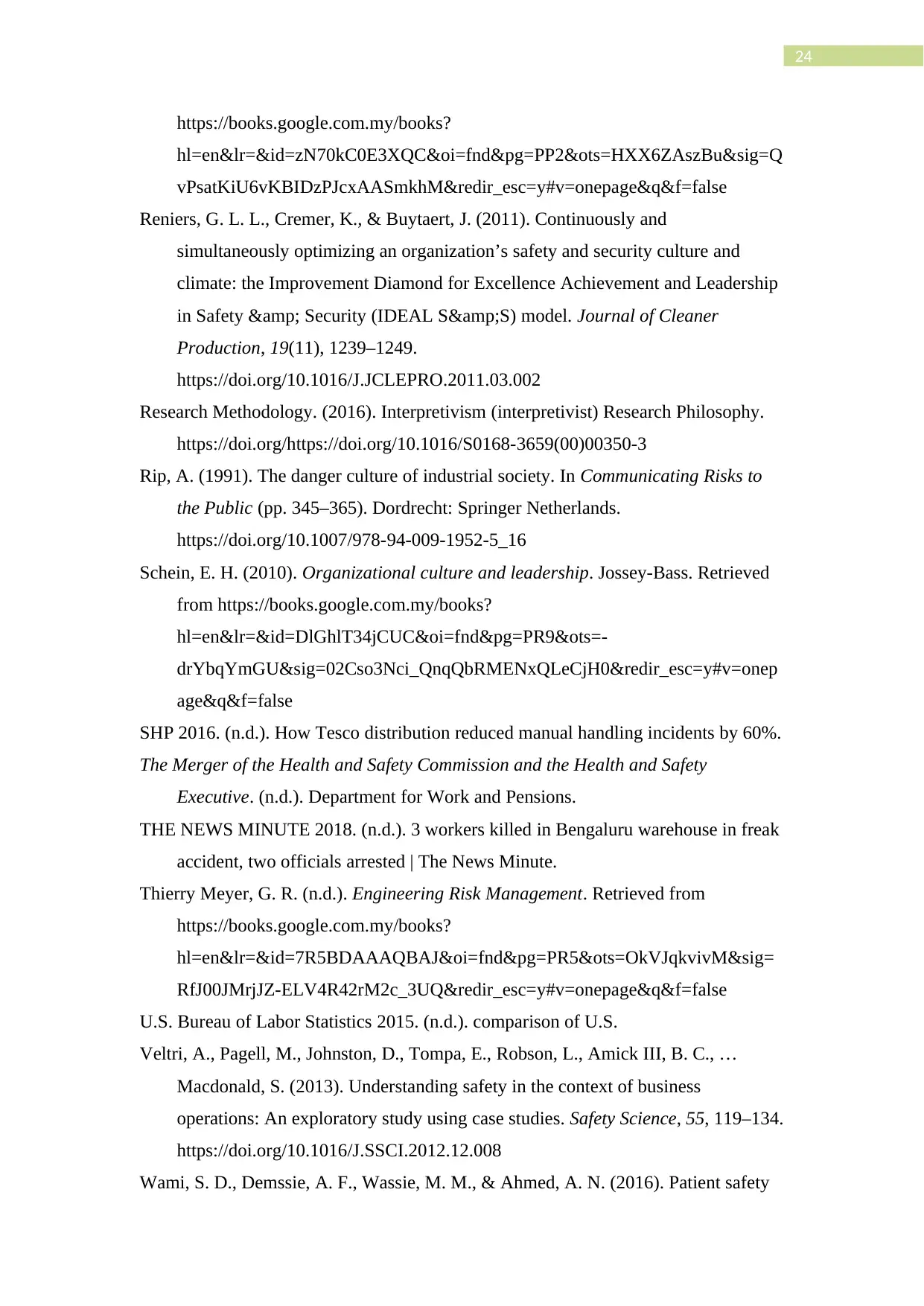
24
https://books.google.com.my/books?
hl=en&lr=&id=zN70kC0E3XQC&oi=fnd&pg=PP2&ots=HXX6ZAszBu&sig=Q
vPsatKiU6vKBIDzPJcxAASmkhM&redir_esc=y#v=onepage&q&f=false
Reniers, G. L. L., Cremer, K., & Buytaert, J. (2011). Continuously and
simultaneously optimizing an organization’s safety and security culture and
climate: the Improvement Diamond for Excellence Achievement and Leadership
in Safety & Security (IDEAL S&S) model. Journal of Cleaner
Production, 19(11), 1239–1249.
https://doi.org/10.1016/J.JCLEPRO.2011.03.002
Research Methodology. (2016). Interpretivism (interpretivist) Research Philosophy.
https://doi.org/https://doi.org/10.1016/S0168-3659(00)00350-3
Rip, A. (1991). The danger culture of industrial society. In Communicating Risks to
the Public (pp. 345–365). Dordrecht: Springer Netherlands.
https://doi.org/10.1007/978-94-009-1952-5_16
Schein, E. H. (2010). Organizational culture and leadership. Jossey-Bass. Retrieved
from https://books.google.com.my/books?
hl=en&lr=&id=DlGhlT34jCUC&oi=fnd&pg=PR9&ots=-
drYbqYmGU&sig=02Cso3Nci_QnqQbRMENxQLeCjH0&redir_esc=y#v=onep
age&q&f=false
SHP 2016. (n.d.). How Tesco distribution reduced manual handling incidents by 60%.
The Merger of the Health and Safety Commission and the Health and Safety
Executive. (n.d.). Department for Work and Pensions.
THE NEWS MINUTE 2018. (n.d.). 3 workers killed in Bengaluru warehouse in freak
accident, two officials arrested | The News Minute.
Thierry Meyer, G. R. (n.d.). Engineering Risk Management. Retrieved from
https://books.google.com.my/books?
hl=en&lr=&id=7R5BDAAAQBAJ&oi=fnd&pg=PR5&ots=OkVJqkvivM&sig=
RfJ00JMrjJZ-ELV4R42rM2c_3UQ&redir_esc=y#v=onepage&q&f=false
U.S. Bureau of Labor Statistics 2015. (n.d.). comparison of U.S.
Veltri, A., Pagell, M., Johnston, D., Tompa, E., Robson, L., Amick III, B. C., …
Macdonald, S. (2013). Understanding safety in the context of business
operations: An exploratory study using case studies. Safety Science, 55, 119–134.
https://doi.org/10.1016/J.SSCI.2012.12.008
Wami, S. D., Demssie, A. F., Wassie, M. M., & Ahmed, A. N. (2016). Patient safety
https://books.google.com.my/books?
hl=en&lr=&id=zN70kC0E3XQC&oi=fnd&pg=PP2&ots=HXX6ZAszBu&sig=Q
vPsatKiU6vKBIDzPJcxAASmkhM&redir_esc=y#v=onepage&q&f=false
Reniers, G. L. L., Cremer, K., & Buytaert, J. (2011). Continuously and
simultaneously optimizing an organization’s safety and security culture and
climate: the Improvement Diamond for Excellence Achievement and Leadership
in Safety & Security (IDEAL S&S) model. Journal of Cleaner
Production, 19(11), 1239–1249.
https://doi.org/10.1016/J.JCLEPRO.2011.03.002
Research Methodology. (2016). Interpretivism (interpretivist) Research Philosophy.
https://doi.org/https://doi.org/10.1016/S0168-3659(00)00350-3
Rip, A. (1991). The danger culture of industrial society. In Communicating Risks to
the Public (pp. 345–365). Dordrecht: Springer Netherlands.
https://doi.org/10.1007/978-94-009-1952-5_16
Schein, E. H. (2010). Organizational culture and leadership. Jossey-Bass. Retrieved
from https://books.google.com.my/books?
hl=en&lr=&id=DlGhlT34jCUC&oi=fnd&pg=PR9&ots=-
drYbqYmGU&sig=02Cso3Nci_QnqQbRMENxQLeCjH0&redir_esc=y#v=onep
age&q&f=false
SHP 2016. (n.d.). How Tesco distribution reduced manual handling incidents by 60%.
The Merger of the Health and Safety Commission and the Health and Safety
Executive. (n.d.). Department for Work and Pensions.
THE NEWS MINUTE 2018. (n.d.). 3 workers killed in Bengaluru warehouse in freak
accident, two officials arrested | The News Minute.
Thierry Meyer, G. R. (n.d.). Engineering Risk Management. Retrieved from
https://books.google.com.my/books?
hl=en&lr=&id=7R5BDAAAQBAJ&oi=fnd&pg=PR5&ots=OkVJqkvivM&sig=
RfJ00JMrjJZ-ELV4R42rM2c_3UQ&redir_esc=y#v=onepage&q&f=false
U.S. Bureau of Labor Statistics 2015. (n.d.). comparison of U.S.
Veltri, A., Pagell, M., Johnston, D., Tompa, E., Robson, L., Amick III, B. C., …
Macdonald, S. (2013). Understanding safety in the context of business
operations: An exploratory study using case studies. Safety Science, 55, 119–134.
https://doi.org/10.1016/J.SSCI.2012.12.008
Wami, S. D., Demssie, A. F., Wassie, M. M., & Ahmed, A. N. (2016). Patient safety
Paraphrase This Document
Need a fresh take? Get an instant paraphrase of this document with our AI Paraphraser
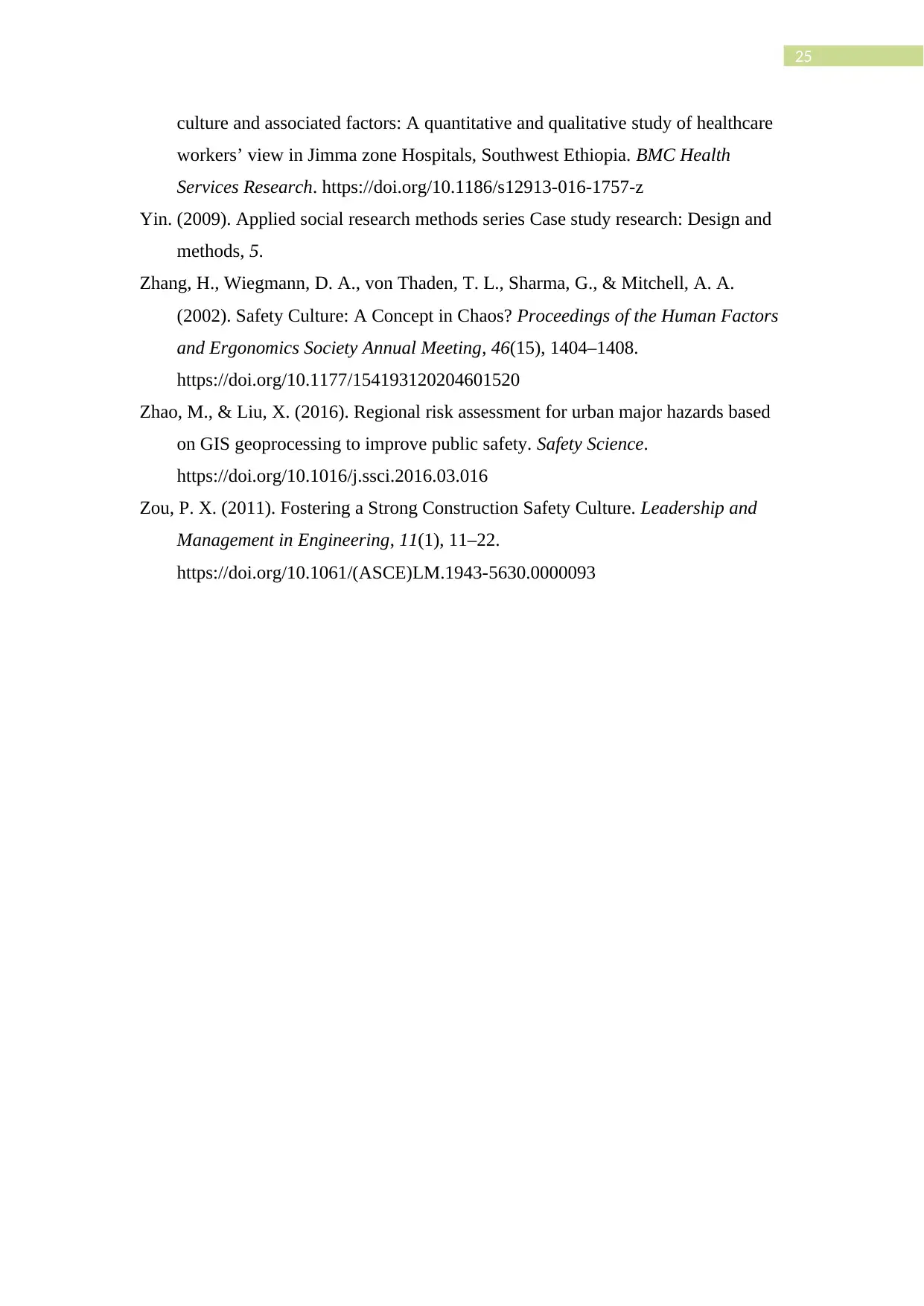
25
culture and associated factors: A quantitative and qualitative study of healthcare
workers’ view in Jimma zone Hospitals, Southwest Ethiopia. BMC Health
Services Research. https://doi.org/10.1186/s12913-016-1757-z
Yin. (2009). Applied social research methods series Case study research: Design and
methods, 5.
Zhang, H., Wiegmann, D. A., von Thaden, T. L., Sharma, G., & Mitchell, A. A.
(2002). Safety Culture: A Concept in Chaos? Proceedings of the Human Factors
and Ergonomics Society Annual Meeting, 46(15), 1404–1408.
https://doi.org/10.1177/154193120204601520
Zhao, M., & Liu, X. (2016). Regional risk assessment for urban major hazards based
on GIS geoprocessing to improve public safety. Safety Science.
https://doi.org/10.1016/j.ssci.2016.03.016
Zou, P. X. (2011). Fostering a Strong Construction Safety Culture. Leadership and
Management in Engineering, 11(1), 11–22.
https://doi.org/10.1061/(ASCE)LM.1943-5630.0000093
culture and associated factors: A quantitative and qualitative study of healthcare
workers’ view in Jimma zone Hospitals, Southwest Ethiopia. BMC Health
Services Research. https://doi.org/10.1186/s12913-016-1757-z
Yin. (2009). Applied social research methods series Case study research: Design and
methods, 5.
Zhang, H., Wiegmann, D. A., von Thaden, T. L., Sharma, G., & Mitchell, A. A.
(2002). Safety Culture: A Concept in Chaos? Proceedings of the Human Factors
and Ergonomics Society Annual Meeting, 46(15), 1404–1408.
https://doi.org/10.1177/154193120204601520
Zhao, M., & Liu, X. (2016). Regional risk assessment for urban major hazards based
on GIS geoprocessing to improve public safety. Safety Science.
https://doi.org/10.1016/j.ssci.2016.03.016
Zou, P. X. (2011). Fostering a Strong Construction Safety Culture. Leadership and
Management in Engineering, 11(1), 11–22.
https://doi.org/10.1061/(ASCE)LM.1943-5630.0000093
1 out of 26
Your All-in-One AI-Powered Toolkit for Academic Success.
+13062052269
info@desklib.com
Available 24*7 on WhatsApp / Email
![[object Object]](/_next/static/media/star-bottom.7253800d.svg)
Unlock your academic potential
© 2024 | Zucol Services PVT LTD | All rights reserved.





